The Jefferson-Madison Debates: Reopening the American Mind
September 12th, 2018 // 8:15 am @ Oliver DeMille
Challenges for the Millennial Generation (and Z)
“Miss Amelia prayed as if the Lord were ten million miles away,
and she would be surprised to pieces
if she got anything she wanted.”
—Gene Stratton-Porter, Laddie
THE PROBLEM?
 Millennials. Or, as they are frequently called by critics, the “Snowflake Generation”. Considered by some the weakest generation in the last hundred years, and criticized, fairly or not, as “the Me Me Me generation…lazy, entitled narcissists who still live with their parents”[1] until age 30 or beyond. Born after 1984, the oldest of them are 30-34, the youngest (born 9/11), sometimes called Generation Z) are still 9-17. Today’s older teens and “twenty-somethings” make up the bulk of this group. The typical introduction to Millennials and Z goes something like this:
Millennials. Or, as they are frequently called by critics, the “Snowflake Generation”. Considered by some the weakest generation in the last hundred years, and criticized, fairly or not, as “the Me Me Me generation…lazy, entitled narcissists who still live with their parents”[1] until age 30 or beyond. Born after 1984, the oldest of them are 30-34, the youngest (born 9/11), sometimes called Generation Z) are still 9-17. Today’s older teens and “twenty-somethings” make up the bulk of this group. The typical introduction to Millennials and Z goes something like this:
“Millennials got so many participation trophies growing up that…40% believe they should be promoted every two years, regardless of performance.”[2]
Large numbers of them are “technology addicted” and struggle at “keeping a job or a relationship”.[3]
On university campuses, the Millennial/Z’s have headlined numerous trends hailed by critics as spreading emotional weakness. For example, though college was once applauded as a place for young people to challenge themselves intellectually and emotionally by learning a diversity of ideas, the opposite is now true. In a report aptly titled “The Coddling of the American Mind”, The Atlantic noted that in “the name of emotional well-being, college students are increasingly demanding protection from words and ideas they don’t like, and seeking punishment of those who give even accidental offense…. [It is] disastrous for education—and likely to worsen mental health on campus.”[4] Learning opposite views, and how to combat them, is increasingly absent in many classrooms and departments.
 This has gone so far that some students at Harvard Law School recently called for professors “not to teach rape law…lest it cause students distress.”[5] Even discussing or pointing out the wrong side of bad things is in many cases becoming taboo.[6] The article questioned: “What are we doing to our students if we encourage them to develop extra-thin skin just before they leave the cocoon of adult protection?”[7] Answer: training them to seek a similar cocoon even as adults, typically from the government. This is the opposite of what Thomas Jefferson believed universities should be. As the founder of the University of Virginia, he wrote:
This has gone so far that some students at Harvard Law School recently called for professors “not to teach rape law…lest it cause students distress.”[5] Even discussing or pointing out the wrong side of bad things is in many cases becoming taboo.[6] The article questioned: “What are we doing to our students if we encourage them to develop extra-thin skin just before they leave the cocoon of adult protection?”[7] Answer: training them to seek a similar cocoon even as adults, typically from the government. This is the opposite of what Thomas Jefferson believed universities should be. As the founder of the University of Virginia, he wrote:
“This institution will be based on the illimitable freedom of the human mind. For here we are not afraid to follow truth wherever it may lead, nor to tolerate any error so long as reason is left free to combat it.”[8]
The Atlantic closed this article with the following words:
“We believe that this is still—and will always be—the best attitude for American universities.”[9]
Today, in contrast, words that are considered offensive are banned from many campuses, as are many ideas or speakers who differ from the politically correct norm. Such schools, and many of their Millennial/Z students do, in fact, appear “afraid to follow the truth wherever it may lead”, or even to listen.
 Surprisingly, the military is dealing with many of the same issues. On the one hand, as James Fallows wrote in The Atlantic in January 2015: “Americans admire the military as they do no other institution. Through the past two decades, respect for the courts, the schools, the press, Congress, organized religions, Big Business, and virtually every other institution in modern life has plummeted. The one exception is the military…. In a Gallup poll last summer, three-quarters of the public expressed ‘a great deal’ or ‘quite a lot’ of confidence in the military. About one-third had comparable confidence in the medical system, and only 7 percent in Congress.”[10] In 2018 American confidence in the military is still at 74%.[11] (Confidence in newspapers is 23%, public schools 29%, banks 30%, courts 22%, TV news 20%, organized religion 38%, small business 67%, big business 25%.[12])
Surprisingly, the military is dealing with many of the same issues. On the one hand, as James Fallows wrote in The Atlantic in January 2015: “Americans admire the military as they do no other institution. Through the past two decades, respect for the courts, the schools, the press, Congress, organized religions, Big Business, and virtually every other institution in modern life has plummeted. The one exception is the military…. In a Gallup poll last summer, three-quarters of the public expressed ‘a great deal’ or ‘quite a lot’ of confidence in the military. About one-third had comparable confidence in the medical system, and only 7 percent in Congress.”[10] In 2018 American confidence in the military is still at 74%.[11] (Confidence in newspapers is 23%, public schools 29%, banks 30%, courts 22%, TV news 20%, organized religion 38%, small business 67%, big business 25%.[12])
On the other hand, a negative term now used in some circles to describe America is “Chickenhawk Nation”, because many Americans are willing for the United States “to go to war, as long as someone else is going.”[13] While three-fourths of Americans admire the military, less than a quarter support their children joining any of the armed services.[14] Moreover, a majority of parents actively discourage or oppose military service by their own children.
Beyond this, only 29% of Millennials now meet the eligibility requirements for military service, causing shortfalls in recruiting needs.[15] And in recent years, “the number of eligible enlistees has been smaller and smaller.”[16] This is largely a matter of physical readiness—or in this case, it’s lack.[17] The snowflake trend has had a significant impact on the fitness levels of American youth.
 On the political front, in the post Bernie Sanders era, many Millennial/Z’s support government-mandated free college, free housing, a monthly wage for everyone whether or not they have a job, and the appeal of “socialism.” Many even like the word or label of “socialism”, with over half of Millennials self-identifying as “socialist”.[18] But, ironically, they have little appetite for the “struggle of the working class to create a socialist society.” [19] That’s too much work. And they certainly aren’t looking for “the long revolution” to bring about socialism.[20] They just want socialist programs handed to them by big government, without the struggle, sacrifice, or effort.[21] Many Millennial/Z’s seem to feel they “deserve” such programs, without doing anything to earn them.[22]
On the political front, in the post Bernie Sanders era, many Millennial/Z’s support government-mandated free college, free housing, a monthly wage for everyone whether or not they have a job, and the appeal of “socialism.” Many even like the word or label of “socialism”, with over half of Millennials self-identifying as “socialist”.[18] But, ironically, they have little appetite for the “struggle of the working class to create a socialist society.” [19] That’s too much work. And they certainly aren’t looking for “the long revolution” to bring about socialism.[20] They just want socialist programs handed to them by big government, without the struggle, sacrifice, or effort.[21] Many Millennial/Z’s seem to feel they “deserve” such programs, without doing anything to earn them.[22]
Such young people are, in short, on a path toward something far removed from traditional American values or freedoms. They will become the biggest block of eligible voters in the 2018 midterm elections,[23] though most of them didn’t actually vote in 2016 and probably won’t until 2020 or beyond.
Is this generation exhibiting the characteristics we want for America’s future? After all, the word “generation” comes from “gene”, or “genes”. What we choose becomes who we are, and influences what we pass on to posterity.
 A more immediate question: Why are many Millennial/Z’s this way? Many analysts blame it mostly on helicopter parenting—a generation over-programmed, over-protected, promised success without sacrifice or hard work by doting parents who sheltered their children from hard things. As one report from England put it: “Millennials are struggling at work because their parents ‘gave them medals for coming last’”.[24] Of course, there are exceptions to these patterns in the Millennial/Z generation, but the trend is still sobering. A lot of Millennial/Z’s do expect college, promotions, income, work and relationships to be easy, and when they aren’t, they expect the government to intervene and somehow make things easy for them. This will certainly impact our politics and policies—and soon.
A more immediate question: Why are many Millennial/Z’s this way? Many analysts blame it mostly on helicopter parenting—a generation over-programmed, over-protected, promised success without sacrifice or hard work by doting parents who sheltered their children from hard things. As one report from England put it: “Millennials are struggling at work because their parents ‘gave them medals for coming last’”.[24] Of course, there are exceptions to these patterns in the Millennial/Z generation, but the trend is still sobering. A lot of Millennial/Z’s do expect college, promotions, income, work and relationships to be easy, and when they aren’t, they expect the government to intervene and somehow make things easy for them. This will certainly impact our politics and policies—and soon.
SOLUTIONS
“The government and its chiefs do not have
the powers of the mythical Santa Claus.”
—Ludwig von Mises
 Despite the Tiger-Mom vs. Cool Mom debates,[25] many parents of Millennial/Z’s “have now realised [British spelling] that their well-intentioned parenting strategies have backfired.”[26] As a result, a number of people are trying to fix what many consider the “helicopter-parent/snowflake/wimpy-generation” debacle.
Despite the Tiger-Mom vs. Cool Mom debates,[25] many parents of Millennial/Z’s “have now realised [British spelling] that their well-intentioned parenting strategies have backfired.”[26] As a result, a number of people are trying to fix what many consider the “helicopter-parent/snowflake/wimpy-generation” debacle.
For example, in 2016 Parents.com listed the number one trend in parenting as “Saying bye-bye to helicoptering…just being more laid back when it comes to managing kids’ lives and schedules.”[27] In another trend, Free Range Parenting has recently popularized the “concept of raising children in the spirit of encouraging them independently and with [less] parental supervision”, including more “realistic personal risks.”[28]
Another example: A youth-initiated movement came from teens Alex and Brett Harris in their book Do Hard Things, which called upon youth to expect more from themselves and move past the limiting beliefs of helicopter parents. The subtitle of this book says it all: A Teenage Rebellion Against Low Expectations. In our day and age, and any other time in world history for that matter, a true “rebellion against low expectations” can only be accomplished by doing hard things, including a lot of hard work.
They wrote: “Most people don’t expect you to understand what we’re going to tell you in this book. And even if you understand, they don’t expect you to care. And even if you care, they don’t expect you to do anything about it. And even if you do something about it, they don’t expect it to last. We do.” This bestseller helped a number of Millennials embrace the idea of “doing hard things”, even in the face of a society that too often militates against teens or parents who seek—or even allow—anything difficult. Author Connor Boyack shows young people and their parents how to embrace this at an even higher level in his excellent book Passion-Driven Education.
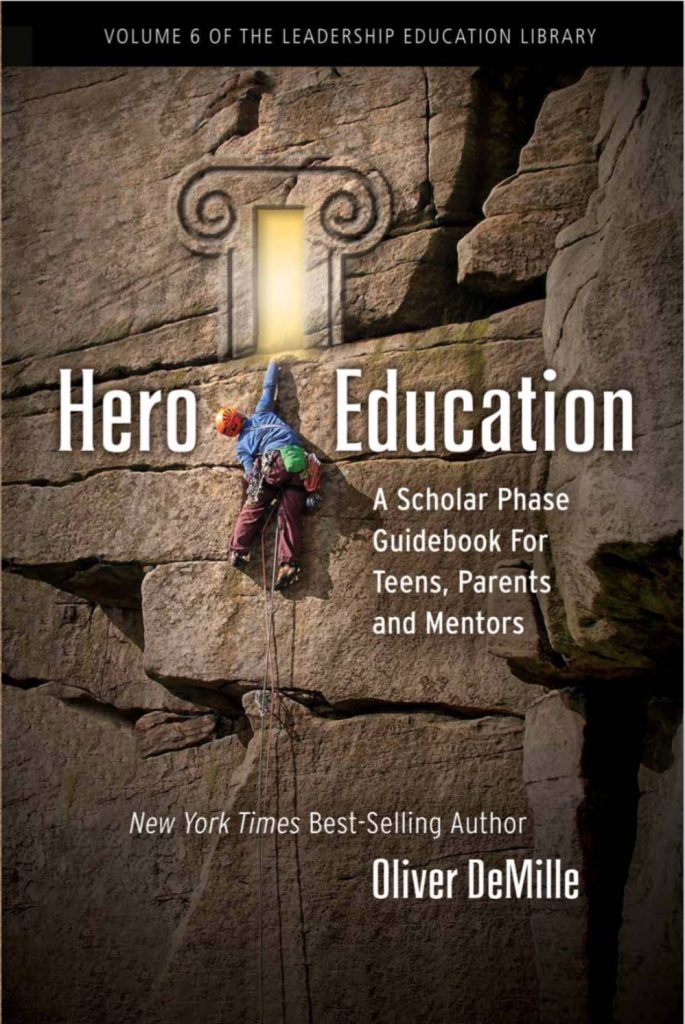 Despite some real progress for a few families and youth in this arena, for far too many of today’s young people the generational tide continues in the direction of easy or easier, adult-sanctioned snowflake weakness, trophies for everyone, and a culture of “blame your parents” (or your teachers, or anyone but yourself), “embrace feelings of unearned entitlement”, “turn to the government to fix anything you don’t like”, and “never take the hard path of extreme work, sacrifice, risk, and great achievement”. More and more parents are realizing the problem—the disaster, really—with this approach, and looking for an antidote.
Despite some real progress for a few families and youth in this arena, for far too many of today’s young people the generational tide continues in the direction of easy or easier, adult-sanctioned snowflake weakness, trophies for everyone, and a culture of “blame your parents” (or your teachers, or anyone but yourself), “embrace feelings of unearned entitlement”, “turn to the government to fix anything you don’t like”, and “never take the hard path of extreme work, sacrifice, risk, and great achievement”. More and more parents are realizing the problem—the disaster, really—with this approach, and looking for an antidote.
We have personally witnessed this generational struggle as we have promoted the principles of great education in our Thomas Jefferson Education (TJEd) system. Our call for Scholar Phase, an intense teen study program of voluntarily putting in massive effort and work to earn a truly great education, is often considered unrealistic by the old guard. But it has been revolutionary and incredibly successful for those (Millennial/Z’s and parents) who have risen to the challenge.
We have seen firsthand that many teens can do very, very hard things.[29] Moreover, once they get a taste for it, they frequently fall in love with the challenge.[30] This inspired me to write the book Hero Education, which builds on the theme of young people accomplishing great things by voluntary action, personal initiative, and hard work. Also, in our experience with TJEd, the best results frequently come where parents and mentors not only encourage great effort, but also lead the way—showing their teens what to do by personal example.
PART II
A RADICAL (AND SURPRISING) SUGGESTION!
“Did you ever wish with all your might that something would happen, and wait for it, expect it, and long for it, and nothing did, until it grew so bad, it seemed as if you had to go on another minute you couldn’t bear it?” —Gene Stratton-Porter, Laddie
 I recently read a report that encouraged even more success of this type. It was both intriguing and fascinating. It may be the best thing I’ve read specifically on the challenges of Millennials and Gen Z (and helicopter vs. leadership parenting) since Allan Bloom’s The Closing of the American Mind. It is found in Outside magazine, and entitled: “Rewilding the American Child.”
I recently read a report that encouraged even more success of this type. It was both intriguing and fascinating. It may be the best thing I’ve read specifically on the challenges of Millennials and Gen Z (and helicopter vs. leadership parenting) since Allan Bloom’s The Closing of the American Mind. It is found in Outside magazine, and entitled: “Rewilding the American Child.”
That’s right:
re – wild – ing
Emphasis on “wild”.
I’m so intrigued by this concept that whenever I think of it I feel this word needs a good ! ! ! to punctuate it effectively. And note that the word “rewilding” is an active verb, like learning, reading, discussing, or loving.
Or jumping, running, hiking, swimming, etc.
Profound.
The report begins:
“Overscheduled.
“Addicted to screens.
“It’s time to set our kids free.”[31]
Freedom. What a great idea. Especially applied to education.
Indeed, the recommendations go a step past free-range childhood—all the way to the wilds. Literally.
From the report:
 “Our children are in crisis…. creating a generation of entitled wimps…. Today, America’s kids are caught up in one of the largest mass migrations in human history: the movement indoors.”[32]
“Our children are in crisis…. creating a generation of entitled wimps…. Today, America’s kids are caught up in one of the largest mass migrations in human history: the movement indoors.”[32]
This is a momentous statement. Take a moment to re-read the last quote and let it sink in. This is big. Here’s more:
“Only recently have we begun to spend our lives penned in by walls, staring at screens.”[33]
Indeed, we’re living through a major development in human history. The full ramifications of this alteration from all past history are yet unknown, but it is already clear that the rise of institutionally-designed “wimpy-ness” is both real and, unless something changes, “the new normal.”
 The impact on society is drastic. This shift has coincided with a rise in the average age of young people becoming independent—with increased dependence in where they live, their finances, and their emotional development. In a reversal of progress, 30 is now the new 18. Adulthood is increasingly put off until later. Marriage, having children, accepting increased career responsibility—all are procrastinated by the bulk of Millennials. And Z’s are following suit.
The impact on society is drastic. This shift has coincided with a rise in the average age of young people becoming independent—with increased dependence in where they live, their finances, and their emotional development. In a reversal of progress, 30 is now the new 18. Adulthood is increasingly put off until later. Marriage, having children, accepting increased career responsibility—all are procrastinated by the bulk of Millennials. And Z’s are following suit.
The “Rewilding” report recommends things that will seem extreme to some, reckless to others, but get right to the core of what many consider the problem of the so-called “Wimpy Generation”.[34] These suggestions include:
“It’s time to make childhood an adventure again. Kids deserve the chance to explore nature without an agenda or a chaperone, to take risks and learn to get themselves out of trouble, to fall in love with nature…”[35]
I’m reminded of something penned by Lord Byron:
“There is pleasure in the pathless woods, there is rapture in the lonely shore, there is society where none intrudes, by the deep sea, and the music in its roar. I love not man the less, but Nature more.”[36]
A generation that seldom spends real time in the real out-of-doors is deprived of so much, too often oblivious to large swaths of learning and therefore to key parts of life, self, and purpose. Another important quote, this one from Henry James, further illustrates the challenge:
Summer afternoon–summer afternoon;
to me these have always been the two most beautiful words
in the English language.[37]
But if we’re caught in the Trapped-Indoors rut, summer differs very little from any other season. Screens are all that matter. Trees, waves, leaves, clouds, rain, even books in many cases, are foreign. Alien even.
What kind of education, or life, is this?
“Look deep into nature,” Albert Einstein is credited with saying, “and then you will understand everything better.”[38]
 Years ago I took a group of college students on a field trip many hours from home. We stayed one night at a beautiful old estate, and when we first arrived we walked through the house and around the grounds. Almost immediately, as we moved into the large fields at the back of the home, one student noticed a huge old tree and gleefully ran to it and climbed up the branches far above the ground. Several other students followed her, and they sat together in their leafy perch and talked for hours about the books we were covering in class at the time, the connections of these books to life, and other important ideas.
Years ago I took a group of college students on a field trip many hours from home. We stayed one night at a beautiful old estate, and when we first arrived we walked through the house and around the grounds. Almost immediately, as we moved into the large fields at the back of the home, one student noticed a huge old tree and gleefully ran to it and climbed up the branches far above the ground. Several other students followed her, and they sat together in their leafy perch and talked for hours about the books we were covering in class at the time, the connections of these books to life, and other important ideas.
I recently returned to the same estate, and pointed out the great tree to a couple of my own children. They marveled at it, as did I. As they climbed, I found myself surprised that more than a decade earlier I had never even considered the safety of those climbing the tree. The world has changed much during the ensuing years, and in the current environment I quickly realized that an extreme focus on safety would have been one of my first concerns if that event had happened today. To the point that I’m sure I would have told the students to climb down immediately.
That would have been tragic. Yet in our sadly “unwilded” and “newly indoor” world, things have changed, and not for the good. “The undiscovered country”, Shakespeare told us, “from whose bourn No traveller returns.” He was speaking, of course, of death. But could the same thinking be applied to the Generation of Screens—once in their grip, No Traveller really returns? Are we now prisoners of the walls and silicon processors that so dominantly define our age and control so many of today’s values?
Perhaps this goes too far, but does our concern about the loss of nature for so many young people extend far enough? Are we even aware of the problem?
One of the best things about the “Rewilding” report is that is doesn’t fall into the almost universal modern educational trap of recommending a solution for the kids only—while the parents stay inside with their thumbs addictively swiping screens. The parents are in fact counseled that to really see a change in their youth they’ll need to lead the way, by showing “them that we, too, love to play outside.”[39] If we added the words “work” and “read” to this sentence, it would be almost ideal. Plato and Aristotle would agree, I think. Thomas Jefferson, whose two favorite pastimes were walking in the wilds and reading, would certainly approve.
 The report recommends a number of options for “rewilding” our kids, including:
The report recommends a number of options for “rewilding” our kids, including:
- “Explore together”
- “Establish Boundaries”
- “Work the Farm”
- “Take back roads…”
- “Fuel their love of games…”
- “…go rafting, take backcountry ski trips, and spend long days hiking…”
- “Age-Appropriate Adventure”
- “A Deep Connection With Animals”
- “Make Sports Fun Again”
The report in Outside magazine, the September 2018 issue, elaborates on all of these and includes many more suggestions; I highly recommend it. The report notes that it is of course important to establish effective safety and other guidelines and rules in all of this, and to make good choices. (Such a disclaimer is probably NECESSARY if Boomers and Gen Xers are reading. But it increasingly appears that risk is the major ingredient missing in the lives of what so many consider the Wimpy Generation.)
In short, with wise planning and implementation, each young person’s education can be greatly improved through outdoor activities…
 HARD STOP. Here is what one Millennial/Z teen told me when I read this article with him (this exact article, the one you’re reading now). He interrupted me at this point, after the disclaimer in the paragraph above, and said: “Fine. But it is just as important, maybe more important, to help them be strong. Far too often, parents equate ‘safe’ with ‘good’, and the result is just weakness. Many kids are held back by frightened, overprotective parents. Our modern society is so skewed to the side of coddling us that strength is usually missing.”
HARD STOP. Here is what one Millennial/Z teen told me when I read this article with him (this exact article, the one you’re reading now). He interrupted me at this point, after the disclaimer in the paragraph above, and said: “Fine. But it is just as important, maybe more important, to help them be strong. Far too often, parents equate ‘safe’ with ‘good’, and the result is just weakness. Many kids are held back by frightened, overprotective parents. Our modern society is so skewed to the side of coddling us that strength is usually missing.”
When I tried to point out the need for balance in this, he interrupted again: “In truth,” he said, “strength is ultimately the only safety. Adults know this. But they act like their kids will never need to be strong.”
I tried to reiterate my point about balance, and he shook his head. “Listen to me. At some point, the kid will have to walk out into the real world. Period.” Then, after a pause, “Prepare them now. That’s what we need from parents.”[40]
THE LONELY
“‘Difficulty’ is the name of an ancient tool
that was created purely to help us define who we are.”
—Paulo Coelho
 The “Rewilding” report also points out another truly profound reality:
The “Rewilding” report also points out another truly profound reality:
“Today’s kids are lonelier than any previous generation.”[41]
This rings all too true to anyone who works a lot with youth. Modernity has taken its toll. The constant connection with screens, and indoor physical separation from other people, too often gets in the way of other more important connections—with parents, siblings, pets, nature, mentors, hobbies, work toward great goals and passions, books, talents and interests, challenging problems and overcoming them, the kind of lessons that are learned only from struggle, etc. These are seldom the skills learned on screens.
A funny joke circulating on the Internet reads something like this:
The Wi-Fi in my house went down for a few minutes
I had to spend time with my family.
They seem like good people…
But is this really funny? In Millennial/Z humor, the several youth I’ve asked assure me, it’s hilarious. For the rest of us, it’s pretty dark. (When one of my Millennial daughters read this, she said the whole joke was actually terrible. Why? Because she was horrified that the Wi-Fi went out at all. “That’s infuriating!” she exclaimed. Another daughter’s big concern was why the person didn’t have data on their phone so they could stay on the Internet even without Wi-Fi. What is she talking about????)
 Humor aside, today’s epidemic of so many teens and twenty-somethings (and even some in their thirties) who put off adult responsibility and remain weakly dependent on authority figures for…well, almost everything…may well be a natural result of the migration indoors.[42] The “snowflake” view of so many on college campuses is indicative of this trend. What is needed in today’s world—our homes, our communities, our learning environments—is a major injection of grit.[43] Of initiative, stamina, guts, and tenacity. And these things are nearly always learned away from screens.
Humor aside, today’s epidemic of so many teens and twenty-somethings (and even some in their thirties) who put off adult responsibility and remain weakly dependent on authority figures for…well, almost everything…may well be a natural result of the migration indoors.[42] The “snowflake” view of so many on college campuses is indicative of this trend. What is needed in today’s world—our homes, our communities, our learning environments—is a major injection of grit.[43] Of initiative, stamina, guts, and tenacity. And these things are nearly always learned away from screens.
In short, technology is a wonderful and powerful tool; few would dispute this. But it is not the only wonderful and powerful tool. A list of tools that are even more wonderful and more powerful include those just outlined above: parents, siblings, pets, nature, mentors, hobbies, work toward great goals and passions, books, talents and interests, challenging problems and overcoming them, the kind of lessons that are learned only from struggle, etc.
The great challenge—and fix—for Millennial/Z’s is to find and implement the right combination of ALL these tools. To be honest, this is true for non-Millennials as well. Put simply, it’s time to re-open the American mind. And get outside…a lot.
Note that doing this is going to be hard. Which is exactly what we need.
“…what you learn there doesn’t amount to a hill of beans compared to what you can find out yourself outdoors. Schoolhouses are made wrong. If they must be, they should be built in a woods pasture beside a stream, where you could wade, swim, and be comfortable in summer, and slide and skate in winter. The windows should be cut to the floor, and stand wide open, so birds and butterflies could pass through. You ought to learn your geography by climbing a hill, walking through a valley, wading creeks, making islands in them, and promontories, capes, and peninsulas along the banks. You should do your arithmetic sitting under trees…”
—Gene Stratton-Porter, Laddie
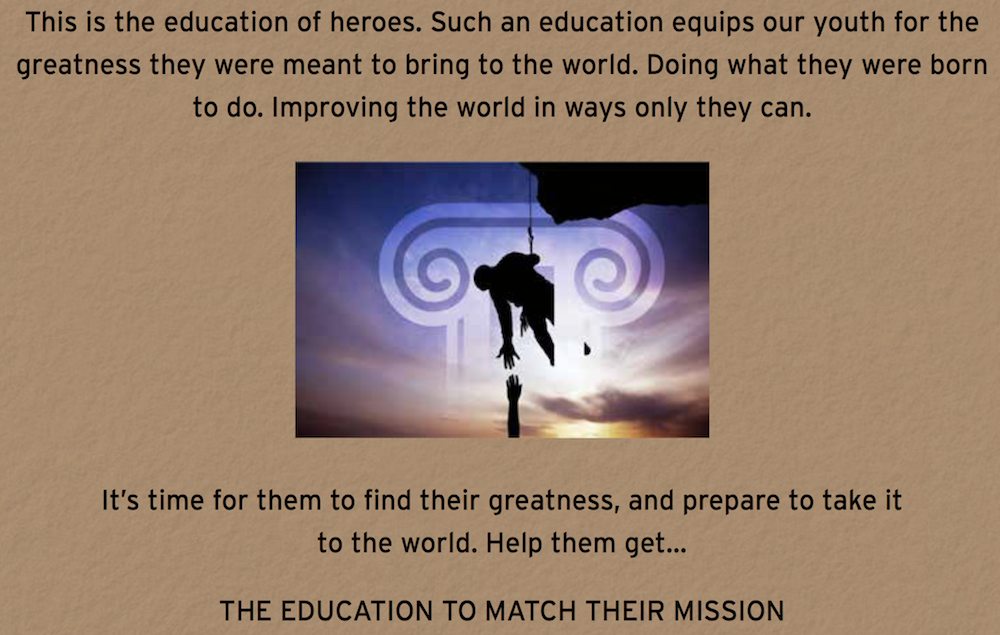
(For more on this topic, especially real solutions, see Hero Education by Oliver DeMille)
(For a Funny Video Click Here>>)
[1] Time, Joel Stein, May 9, 2013
[4] The Atlantic, Greg Lukianoff and Jonathan Haidt, September 2015
[10] The Atlantic, James Fallows, January/February 2015, citing Gallup
[13] The Atlantic, James Fallows, January/February 2015
[14] See The New York Times, Damien Cave, June 3, 2005.
[15] Military1.com, March 6, 2018
[18] American Institute for Economic Research, Max Gulker, December 2017, “Over Half of Millennials Identify as Socialist: Here’s How to Change Their Minds”
[19] See, for example: The New York Times, Michelle Goldberg, June 30, 2018, “The Millennial Socialists Are Coming”; The American Interest, Ben Judah, “What Is Millennial Socialism?”; chicagotribune.com, Heather Wilhelm, July 9, 2018, “Why are millennials so hot for socialism?”
[20] Ibid.
[21] Ibid.
[22] Ibid.
[23] See Politifact, Andy Sherman, February 13, 2018
[24] Independent.co.uk, Rachel Hosie, February 7, 2017
[25] See for example Battle Hymn of the Tiger Mother, by Amy Chua, Bringing Up Bėbė, by Pamela Druckerman, and “Are ‘Tiger Moms’ Better than Cools Moms?” (The Atlantic) by Julia Ryan, among others.
[26] Independent.co.uk, Rachel Hosie, February 7, 2017
[27] Parents.com, Melissa Willets, “6 Parenting Trends to Look Forward to in 2016”
[28] Wikipedia.org, “Free-range parenting”
[29] See Hero Education, Oliver DeMille
[31] Outside, multiple authors, September 2018
[36] Cited in Forest Therapy, 2018, by Sarah Ivens
[39] Outside, multiple authors, September 2018
[40] Ephraim DeMille (age 18 – son of my brother, William), August 2018
[41] Outside, multiple authors, September 2018
[43] See the following: Angela Duckworth, Grit; Claude Hamilton, Thick-Skinned; Claude Hamilton, Toughen Up.
Category : Blog &Citizenship &Community &Culture &Current Events &Economics &Education &Entrepreneurship &Family &Generations &History &Information Age &Leadership &Liberty &Mission &Producers &Prosperity
Jefferson-Madison Debates: A Week of Socialism
August 21st, 2018 // 2:21 pm @ Oliver DeMille
The Media of Our Time
 This week I read five books, and one of them was an easy, enjoyable novel—a western entitled Flint that I’ve read and reread several times. Surprisingly, it was the western that first got me thinking about socialism. It contains a classic East Coast vs. Wild West milieu, where the main character experiences and ultimately chooses the fiercely independent lifestyle of the West over the more “socialized” culture of New York and New England. When I read the other four books they kept challenging my mind with similar themes—the kind that woke me up in the night numerous times with “new” thoughts that somehow refused to wait for morning. Fortunately, I keep a notebook on the nightstand for just such events.
This week I read five books, and one of them was an easy, enjoyable novel—a western entitled Flint that I’ve read and reread several times. Surprisingly, it was the western that first got me thinking about socialism. It contains a classic East Coast vs. Wild West milieu, where the main character experiences and ultimately chooses the fiercely independent lifestyle of the West over the more “socialized” culture of New York and New England. When I read the other four books they kept challenging my mind with similar themes—the kind that woke me up in the night numerous times with “new” thoughts that somehow refused to wait for morning. Fortunately, I keep a notebook on the nightstand for just such events.
Watching and reading the news added to this mental battle, since socialism is making a serious comeback right now in some corners of American politics. But mostly my thoughts centered on the books themselves. The first one after the western got the ball rolling because it openly promotes socialism, the cooperative type that focuses more on economics and culture than politics. It really made me think, because it skipped theory and emphasized current actions. Sobering.
Then I kept reading, and all the books were deep—nothing to skim. Every word was important; every sentence and paragraph deserved consideration.
By the time I finished the last book, I had a lot of ideas bouncing around in my head. As mentioned, the first book was about cooperatives as a replacement for corporate greed—putting “democracy” back in the business world, as the author put it, and a second offered a detailed history of the Supreme Court’s impact on American public education (and its governmental/legal influence on non-public education as well). There are a lot of socialist ties in education, sadly.
The third book amounted to a warning. China is growing—in power, wealth, and global ambition. We seldom hear much in the media about the major China threat, even though it is increasing at a staggering pace. Xi Jinping has centralized power within the People’s Republic of China to a level unprecedented since Mao (some would say with more power than Mao, given China’s huge economy and global reach). China’s plans for the decade ahead are remaking the globe. Yet, again, this is a topic hardly discussed in current America. Both communism and socialism refuse to die or go away; in some ways they are powerfully ascendant right now.
Finally, the last book, really just excerpts from a book that hasn’t yet been fully released, shares Aleksandr Solzhenitsyn’s thoughts about his famous 1978 speech at Harvard. If you’ve ever read A World Split Apart (the Harvard speech), you know it is important, and incredibly powerful. Every idea is profound, and unexpected. The excerpts from his new collection, to be published in late 2018, are equally compelling. In 1978 his words seemed a lot more anti-capitalist than anti-communist or even anti-socialist, but today I kept noticing the way his commentaries on America’s mainstream media crisply poke holes in an industry that has arguably become the world’s leading apologist for socialism. Deep. And this historical trend from 1978 has now become a tidal wave.
Following are my notes and main conclusions on these four books. I think they’re worth considering. There is a lot of important information packed into this article. If you give these ideas a chance, I think they’ll help you think even more deeply—and I hope more wisely as well—about our current events and challenges. It seems increasingly true that in our age of rampantly-partisan media, books frequently tell us more about events than the nightly news. It may be that a return to books (even more than the growth of the Internet) is the actual “new media” of our time. So much of what calls itself media today isn’t journalism at all, but just entertainment for the two major political parties, or worse, strident muckraking. Here goes…
Book One
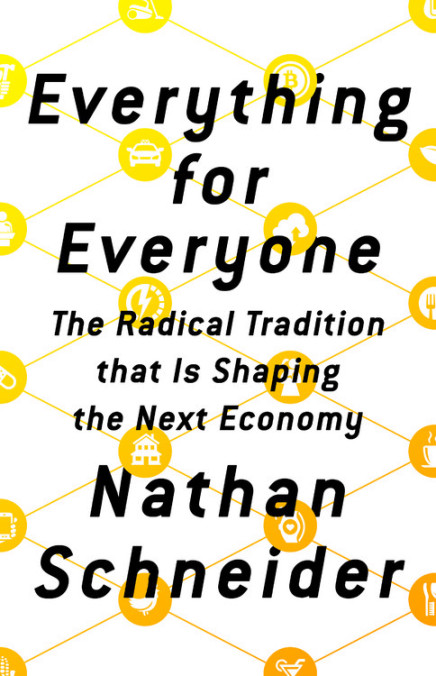 Everything for Everyone (by Nathan Schneider)
Everything for Everyone (by Nathan Schneider)
-
5 Stars for Importance
-
2 Stars for Promoting Freedom
-
4 Stars for Fun
Theme: Like it or Not, Socialism by Any Other Name is Still Socialism (But Capitalism is Either Really Bad or Really Good, Depending…)
The Problem, as described in Everything for Everyone, is that modern capitalism has become an enemy to democracy and culture. The book refers to the American economy as “A new feudalism on the rise” where “monopolistic corporations feed their spoils to the rich [while] more and more of us are expected to live gig to gig.” It traces the history of the idea that the best societies exist where the people share “all things in common”, from medieval monasteries and guilds to modern urban taxi cooperatives taking on Uber, from “freespace” supporters in San Francisco to online platforms, and numerous other examples.
The Solution, according to this book, is the spread cooperatives, groups democratically run by cooperating people—not dominating corporations controlled by a hierarchy of the elite few. Based on the marketing copy, the book appeared to promote an extremist utopia for utopians, which coincides nicely with the increasing popularity of socialism in the Democratic Party. The subtitle (“The Radical Tradition that Is Shaping the Next Economy”) predicts that this Solution is the clear way forward, our best path to a better future. And the author’s most recent book before this one, entitled Thank You, Anarchy: Notes from the Occupy Apocalypse, seems to reinforce this impression. But Everything for Everyone is a lot deeper than it seemed to me at first glance.
Indeed, as I read, I found myself marking numerous sentences, paragraphs, and quotes for future reference. The book is a treasure-trove of thinking on modern problems—clearly coming from a place Left of Center, but not patently anti-capitalist. Again, given the marketing copy, this surprised me. For example, while promoting the virtues of cooperation in very progressive-sounding language, the author also wrote: “Does cooperation count as capitalism, or something else?… If capitalism means freely associating in the economy, or ingenuity and innovation, or the rough-and-tumble of setting up a business, or price-based reasoning—then yes, cooperation overlaps with it. But if capitalism means a system in which the pursuit of profit for investors is the overriding concern, cooperation is an intrusion.”
To be clear, the term “capitalism” is often used in different ways by different people, and has evolved over time. Free Enterprise Capitalism (which promotes “freely associating in the economy… ingenuity and innovation… the rough-and-tumble of setting up a business…”) is not the same thing as Crony Capitalism or what is sometimes termed “Corporate Capitalism”—where institutions with capital are treated differently by government, law, and the commercial code. In Free Enterprise Capitalism, all people and institutions are treated equally by the law; in Corporate/Crony Capitalism the rich are given special legal and financial benefits. In my view, the real negative isn’t what Schneider calls “the pursuit of profit as the overriding concern”, but rather these special legal benefits that are both undemocratic and elitist, and also undermine Free Enterprise.
Overall, I consider this book a great read about our modern world. On the one hand, I heartily agree with its warning against the increasing dangers of government-by-corporate-powers, the Military-Industrial-Complex in its newest form, sometimes called The Black Box Society (another excellent book) or Government by Corporate Algorithm, Crony/Corporate Capitalism, or simply Elitism. The idea that economic progress must be a top-down process controlled by elites—while most people struggle paycheck to paycheck—is the source of many of our modern problems. More people on the Right need to understand and accept this challenge, because it’s real.
At the same time, I have mixed feelings about many of the proposed solutions in Everything for Everyone. Just like capitalism can adopt the empowering Free Enterprise approach or succumb to the controlling Crony/Corporate/Elitist model of capitalism, cooperative organizations and co-ops can be either freedom-supporting grassroots enterprises (which require a free economy if they want to flourish) or force-based. Where the author encourages the first, I like it. When the book promotes the second, not so much.
From the book: “What would it take so that a can-do group of pioneers—people with a need to meet or an idea to share with the world—might conclude that the best, easiest way to build their business is by practicing democracy?” Again, these words seem to lean toward freedom, and certainly the idea of more entrepreneurs and owners in our business structures is appealing. Even necessary, I think. But how easily does this approach turn into force-based controls? Is this joint-ownership system built on contract and market forces, or does it depend upon or even promote government forced “cooperation”? Both iterations will likely be applied.
The reality is that democracy is hard. The reason we use it in government is that government itself is force, and without a healthy dose of official voting power vested in the regular citizens, government will always be dominated by some group of elites—who seldom give the people any real equality (despite promises) or treat the people with respect, or allow any true freedom. And, secondly, the best governments, the free ones, check and balance democratic parts of government with branches that are aristocratic (e.g. Senate), appointed (e.g. Executive), and even appointed by the appointers (e.g. Judiciary).
This has been a long-established reality, even before Aristotle openly pointed it out. In the American arrangement of this model, the Framers made sure democracy had the final say (mostly through the power of the purse held by the democratically-elected House of Representatives), but not the entire say. Such a democratic republic is democratic, yes, but it’s not a pure democracy.
Thus, if most good democratic republics, where democracy has the final say through the purse strings, end up losing their freedoms to aristos and elites (and they do, as Madison pointed out in The Federalist), how much more quickly will this decline occur in democratic cooperatives? On a side note, as I read Everything for Everyone, I kept thinking of another book, similar in some very important ways, entitled Beyond Capitalism and Socialism, edited by Tobias J. Lanz. These two books are worth reading together, comparing and contrasting. Also throw into this conversation the book Give People Money, by Annie Lowry, which I reviewed earlier this year.
Finally, in addition to the important ways Everything for Everyone contributes to the discussion of where we want our economy to go, it is also a valuable book on current politics. For those on the Left, it shares a number of ways people are trying to seek a better economic model for the future—real people, doing real projects. Not just theory, which is often the Achilles heel of proposals from the Left. This provides the most value in the book, in my opinion. For those on the Right, this book strips away many of the stereotypes and misconceptions about the modern Left (the mainstream media version), and will help conservatives and independents understand more deeply what many on the Left are really about. Understanding this is important for everyone.
Book Two
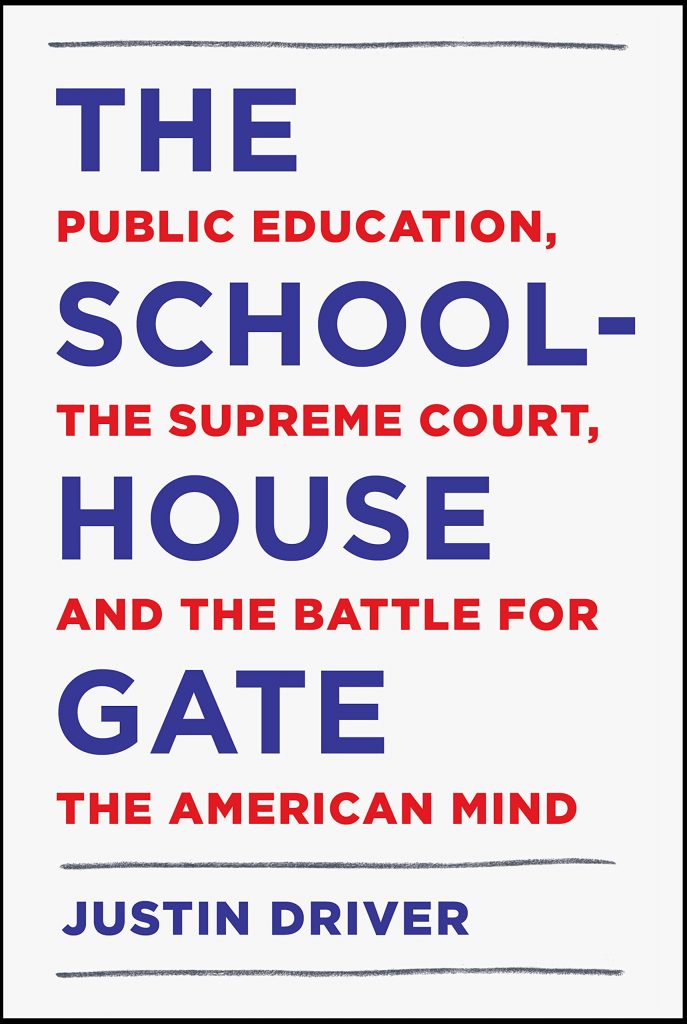 The Schoolhouse Gate (by Justin Driver)
The Schoolhouse Gate (by Justin Driver)
-
5 Stars for Importance
-
3 Stars for Freedom
-
3 Stars for Fun
Theme #1: The Court Gets a Lot of Things Wrong (And It’s Okay to Say So Out Loud…)
Theme #2: The Court is Far Too Involved in Education (The Constitution Mostly Left this to the States, But Try Telling That to the Court…Or Congress, the White House, or Anyone Else in Washington)
First of all, I like that this book seems to take a 3-branch view of the Constitution (that the Supreme Court can be wrong, and often is, and that the Legislative and Executive branches are co-equal with the Judiciary) rather than the erroneous 1-branch view that the Court is the final and highest power in the nation. The 1-branch view is much more common in today’s world, especially in the mainstream media. Putting the topic of education aside for a moment, the 3-branch approach makes this book a rarity, one that is a must-read work for anyone interested in the modern Court. (Another book that effectively speaks from the 3-branch approach, with more specifics, is Constitutional Law by Nowak and Rotunda, Seventh Edition.)
As mentioned, The Schoolhouse Gate is laced with the idea that the Court is sometimes wrong. For example, the author says: “The Supreme Court has also stumbled…” and calls one landmark case “a Constitutionally questionable decision…” The federal Courts in general are said to make “many wrongheaded decisions…” The book is filled with such language, a refreshing approach in our time. Also, one of the best things about this book is that is written for the regular reader, not limited to a few legal scholars.
The focus of The Schoolhouse Gate—Court decisions and trends dealing with American education over time, including recent cases—is must-know information for all informed Americans. In historical scope, it reminds me of Constitutional histories by Forrest McDonald, but with more detail. Most people today don’t know the information outlined in The Schoolhouse Gate; making Driver’s book all the more important. I didn’t agree with all the book’s conclusions, but I did agree with many—and either way the book consistently caused me to think about things I had never really considered.
In my view, the Court has made a few very important decisions about education that are really good for our nation, and a number of bad decisions that aren’t. In most cases, it would be better to leave educational decisions to the states, as per the Constitution. A question that kept recurring in my mind as I read: “Is the Court approach to education rooted more in individual liberty or collectivist socialism?” The answer is far too often, though not always, the latter.
Largely as a result of this, today’s modern schools are in many cases de facto incubators of socialism—from mild to more extreme. This applies not only to elementary and high schools, but to most of higher education as well. The drive is to make schools as similar as possible, often under the guise of “equality” and a professorate made up not just largely, but almost entirely of progressives. Conservatives are a rarity in nearly all the top American institutions of higher learning. In far too many cases, conservative students are penalized for their political views—and a lot of them hide or even change their politics during their time on campus.
What happens to a society where many of the children are raised in conservative or conservative-leaning homes, educated in elementary/secondary schools that lean strongly Left, and then trained in “higher” institutions with a fundamental and passionate allegiance to the Left? In many cases the conservatism of parents and grandparents is mocked as childish, and Leftism is ultimately considered truly “higher” (meaning “better, more advanced, more correct”) learning. The “adults” and “grown ups” in such a model must, by definition, come from the Left (or, if Republican, of the progressive type). This is the fruit of thirty years of infiltration in lower schools and on campus, frequently supported and even encouraged by Court decisions.
Book Three
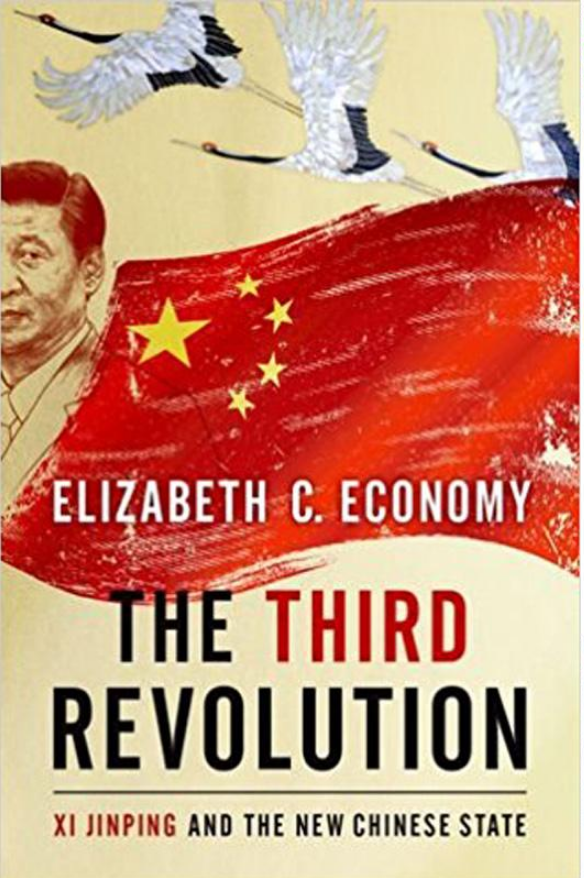 The Third Revolution: Xi Jinping and the New Chinese State
The Third Revolution: Xi Jinping and the New Chinese State
(by Elizabeth C. Economy)
- 5 Stars for Importance
- 4 Stars for Freedom
- 3 Stars for Fun
Theme: While the Media is Overwhelmingly Obsessed with Russia, the Threat from China is Growing at an Alarming Rate
The next ten decades belong to China, if ownership and contractual access to the world’s natural resources are any indication. Historically, these are always the best indication of what’s ahead. Yet, astoundingly, few in current America are giving this the attention it demands. The United States literally may face an existential threat from China in the decades ahead.
Elizabeth C. Economy’s book The Third Revolution makes the case that there have been three great eras in modern China: (1) the Maoist Revolution that brought communism to China, (2) the “Second Revolution” led by Deng and those who came after him, which emphasized more openness—both in China’s domestic economy and in relations with the outside world, and (3) the current “Third Revolution” which focuses on increasing the power of one leader within the nation, Xi Jinping, and boosting China to the pinnacle of power and leadership on the global stage.
Consider the following quotes from Economy’s book:
“The ultimate objective of Xi’s revolution is his Chinese Dream—the rejuvenation of the great Chinese nation…. Xi’s predecessors shared this goal as well. What makes Xi’s revolution distinctive is the strategy he has pursued: [1] the dramatic centralization of authority under his personal leadership; [2] the intensified penetration of society by the state; [3] the creation of a virtual wall of regulations and restrictions that more tightly controls the flow of ideas, culture, and capital into and out of the country; and [4] the significant projection of Chinese power.”
“It represents a reassertion of the state in Chinese political and economic life at home, and a more ambitious and expansive role for China abroad.”
“Unlike his immediate predecessors, he has assumed control of all the most important leading committees and commissions that oversee government policy; demanded pledges of personal loyalty from military and party leaders; eliminated political rivals through a sweeping anticorruption campaign…. [A]dvocates for change or those who seek a greater voice in political life, such as women, labor, or legal rights activists, increasingly risk detention or prison.”
This new approach goes well beyond international economic expansion. For example, as Economy shows, since 2014 Xi’s government has driven “massive land reclamation and militarization of the islands in the South China Sea…. He has established China’s first overseas military logistics base; taken significant [steps to increase]…strategic ports in Europe and Asia; championed China as a leader in addressing global challenges, such as climate change [with China’s largest competitor, the United States, largely footing the bill]; and proposed a number of new trade and security institutions [and a PRC-dominated world reserve currency to replace the U.S. dollar]. Xi seeks to project power in dramatic new ways and reassert the centrality of China on the global stage.”
Note that all of these initiatives and changes began during the Obama era, while the United States struggled in the aftermath of the Great Recession. The economic rebound of the United States, beginning in 2017 and corresponding with a more aggressive foreign policy under the Trump Administration, has changed the dynamic of Chinese-American relations, but China hasn’t changed its trajectory.
Economy points out the drastic significance of the situation:
- “[A]ll the major economies of the world, save China, are democracies.”
- “China is an illiberal state seeking leadership in a liberal world order.”
I consider this one of the most important books of our time. As I’ve said about the other books reviewed here, it is a must-read for anyone who cares about America. And the future of the world, for that matter. It’s that significant.
Economy’s proposed policies and solutions are particularly interesting. Whether you agree with them, or part of them, or disagree, they bring up topics that demand a lot more consideration and discussion by regular Americans. If we don’t engage such conversations, we leave public policy and national direction to a few experts in academia, think tanks, media, and government. This is hardly the American way, though it has dangerously become the norm in many policy debates during recent decades.
An example of Economy’s suggestions is the need to recognize the influence that China now has on American campuses, and how important it is for Americans to learn what is occurring. She wrote: “China under Xi Jinping also seeks to influence the domestic politics of other countries as those politics relate to China. The Chinese government mobilizes students and other citizens living abroad to represent the interests of the Chinese government by, for example, spying on other Chinese students, denouncing professors who offer contrarian opinions [isn’t the purpose of universities in a free society to allow open discussion of differing ideas?], and protesting against invited speakers who criticize China.”
In reality, the media obsession with Russian influence on American elections is ironic given the sheer scope and scale of China’s much bigger presence and influence—not just in the U.S. but also in Europe and around the world. This mirrors the general silence about China (again: the world’s second largest economy, which now rivals the U.S. economy) and daily onslaught of commentary on Russia meddling (the same Russia whose economy is only about half the size of the economy of California). American citizens need more perspective on what’s really happening.
As Economy recommends to the Trump Administration: “… the United States can gain leverage in negotiations with China by understanding domestic dynamics within the country around particular issues.” The interest of Chinese citizens in the English language and American culture, politics, business and society dwarfs the level of American interest or focus on anything Chinese. Our lack of seriousness in this respect is dangerous.
Whether the future will actually be dominated by China remains to be seen. But it is certainly a real possibility, and we are right now on track to see this outcome. If it occurs, it could very well spell disaster for freedom.
Book Four
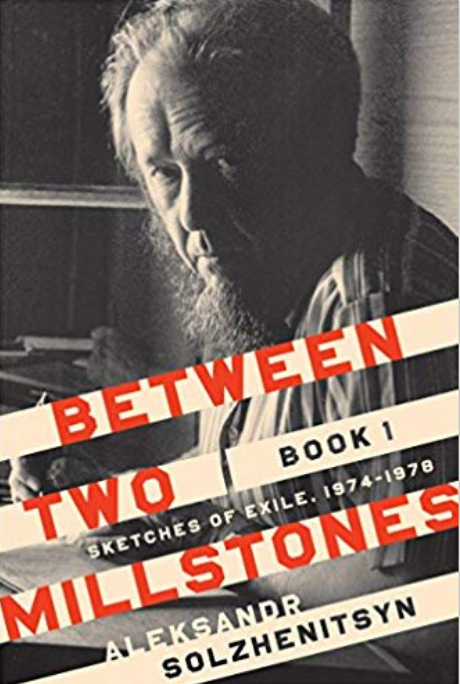 Between Two Millstones, Book I (by Aleksandr Solzhenitsyn, Peter Constantine)
Between Two Millstones, Book I (by Aleksandr Solzhenitsyn, Peter Constantine)
-
5 Stars for Importance
-
5 Stars for Promoting Freedom
-
5 Stars for Fun
Theme: Just Read It—It’s Awesome
When Solzhenitsyn spoke at Harvard in 1978, he caused a firestorm of media criticism. Many expected him to describe the weaknesses and evils of communism, and show the many ways America and the West are better—as he had done in earlier speeches. But at Harvard he targeted a different problem: the systemic flaws and mistakes of Western Civilization, especially in the United States. He attacked the way we do business, our legal system, our colleges and universities, our culture (or more accurately, the ways we lack culture), and above all our modern media.
Decades later, in Between Two Millstones, we get to read and think about his critique of how his speech was received, and why it matters. This provides one of the most poignant descriptions of modern media available. If you haven’t read his speech, published as A World Split Apart, it’s worth studying before you read Two Millstones. Together they provide a powerful commentary, one we should all engage and consider.
Specifically, concerning what we today call the mainstream media, Solzhenitsyn points out that our roots are muddled: “Western society is based on a legal level that is far lower than the true moral yardstick…” Because of this, he argues, we tend to consider something good as long as it is legal, and we usually apply this to all parts of society, including business, family, education, media, etc. Thus media can say whatever it wants, as long as it is legal. Indeed, media doesn’t have to stand for truth, or accuracy, as long as what it says is legal by the letter of the law.
The result is a major power grab, albeit a somewhat subtle one. Solzhenitsyn wrote: “And above all, the press, not elected by anyone, acts high-mindedly and has amassed more power than the legislative, executive, or judicial power.”
This should make every American stop and think deeply. It didn’t quite reach everyone in 1978, but it is still relevant.
He continued: “And in this free press itself, it is not true freedom of opinion that dominates, but the dictates of the political fashion of the moment, which leads to a surprising uniformity of opinion.” He points out that this is the thing that “irritated” the mainstream media the most about his speech. Claiming to be champions of diversity and open thinking, the media is often the enemy of both.
Here are some of the bad habits and underhanded tactics of the mainstream media, as suggested by Solzhenitsyn:
- They “completely” missed the things Solzhenitsyn thought were important about the speech, the very things the speech was actually about, and focused on their own agenda—misrepresenting and tangentially citing his message in order to make it fit their narrative so they could attack it. He called this “a remarkable skill of the media”.
- “They…invented things that simply did not exist in my speech”.
- They “prepared their responses in advance”, and focused their commentary not on what he actually said but on their plans to discount what they anticipated he would say—ready to pounce and then twisting phrases and words to make connections with their pre-designed rebuttals.
- They didn’t just misreport the facts, but in addition “the press spouted scalding invective…” They did this without telling the populace that these were just the opinions of the reporters; instead they acted as if their “invective” and anger were objective and wise. Even true. In reality it was only their opinion, and frequently differed from the facts and what he actually said in the speech.
- Overall the media tends to reject and attack those who criticize them, and reward only those who “flatter” them.
Of course, he expected the mainstream media to disagree with him. After all, he frequently and openly accused the media of many mistakes, including “stuffing” the people’s “souls…with gossip, nonsense, vain talk.” They naturally pushed back.
What did surprise him is what happened in another part of America, away from the centers of power. Solzhenitsyn wrote:
“…one could also begin to read many responses that were markedly distinguished from the arrogant stance of the America of New York and Washington… Gradually another America began unfolding before my eyes, one that was small-town and robust, the heartland, the America I had envisioned…. I now felt a glimmer of hope…”
From the local and non-mainstream media he heard such responses as:
- “We know in our hearts he is right…”
- “His speech ought to be burned into America’s heart. But instead of being read, it was killed” by the mainstream media.
- “Can the press maintain diversity when ultimate control [of the media] rests in the hands of a small group of corporate executives?”
The two Americas were already a reality in 1978. But, like always, the mainstream media paid little heed to the media of “the heartland” or the views of non-elite Americans. To get the real story on things, people will apparently have to see past the mainstream media and find more truthful and more, well… journalistic… sources—and concerning his speeches and books, nothing is better than the original words of Solzhenitsyn himself.
From what I can tell from the early excerpts that are available to read, Between Two Millstones will be a great book, an important read, and one that will make every reader think and rethink. To be published in late 2018, forty years after the Harvard speech, it should be read by everyone who cares about our society and its future.
Conclusion
My stroll through these four books this week (five, if you count the western), with their recurring theme of socialism, from various angles, has prompted me to move even further past the old view that liberalism and conservatism are the dominant political forces of our time. I am increasingly convinced that socialism is powerfully on the rise right now (both in the U.S. and around the world), and that it presents a clear and present danger to freedom.
Above all, I am more convinced than ever of just how important it is for those who care about freedom to read more and raise the awareness of what is at stake in the months and years just ahead. I think books are the true “new media”, while most mainstream news outlets and platforms are mired in non-journalistic battles to promote false narratives. This demands that we, the regular people, take action to dig a lot deeper in our own study of what’s really happening.
A few final questions:
-
What important things are you reading this week and month?
-
What are the “theme units” you’re finding in what you read?
-
Are you writing down your thoughts?
-
With whom are you sharing what you are learning?
Category : Aristocracy &Blog &Book Reviews &Business &Citizenship &Community &Constitution &Culture &Current Events &Economics &Education &Foreign Affairs &Generations &Government &History &Information Age &Leadership &Liberty &Politics
The Madison-Jefferson Debates: What Isn’t True
August 7th, 2018 // 1:22 pm @ Oliver DeMille
Reality or… Not?
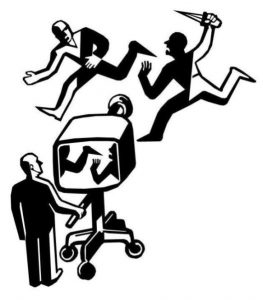 Some things just aren’t true, even if we think they are. Even if we are assured that “everyone” says they’re true; and even if the experts—almost always unnamed—have formed a consensus on the matter. Actually, the more you get know the experts, the more you realize they aren’t in consensus on almost anything.
Some things just aren’t true, even if we think they are. Even if we are assured that “everyone” says they’re true; and even if the experts—almost always unnamed—have formed a consensus on the matter. Actually, the more you get know the experts, the more you realize they aren’t in consensus on almost anything.
Now, let’s be clear. A lot of what we’re told is true. But not everything. And that’s why sometimes it’s important to take a step back and really dig into things. Research. Find out. There are whole websites dedicated to setting the record straight about urban myths, generally accepted “truths”, quotes that are attributed to someone who never said those words, etc. We give “Pinocchios” to politicians who fib, and “Fact Checker” is a growing career field in the Information Age. (Is it really? Or does it just seem like it? Ask the question on Google and you can spend hours studying the various listings. Or ask the same question on social media and wade through hundreds, or even thousands, of opinions.)
Falling for Everything
Here are few items that most people consider truth. Unassailable. Set in stone. Incontrovertible.
- Lie Detector Tests
- DNA Evidence
- Election Polls
- Carbon Dating
Which are sure? Which are certain? Not all. Do you know which of these are fully accepted by the experts in the field—no exceptions? Answer: none. All of the above are rejected by at least some experts, even where a majority of experts agree. Have you studied the arguments, evidence, tests and conclusions on each? Or any? Note that even where the science is firm, like with DNA evidence for example, the way experts present such science is at times incomplete or misleading. Or, another example, even if the statistics used in a pre-election survey are accurate, the wording of a specific survey question can skew the entire result; and what if survey respondents are afraid or ashamed to tell the truth, like in the 2016 U.S. presidential election when many voters didn’t want people to know they planned to vote for Donald Trump? In such cases, the math and the science can be technically correct, but the way experts use them turn out “wrong”, because all the variables aren’t controlled.
In short, on many things we simply know less than we need to. And yet most people are comfortable making decisions based on things they know very little about—just taking someone’s word for it. It’s a habit for most people.
But things are not always what they seem. Truth isn’t always what the experts claim. This doesn’t mean that every crackpot theory questioning the experts is correct. But it does suggest that we should be independent thinkers who read the original data or studies where possible and scrutinize things for ourselves. Independent thinking is required to maintain independence. This is obvious, isn’t it? But most people don’t follow this approach.
Time to Think
For our Madison-Jefferson conversation this week, I’m recommending the attached article. It is a great read, and an important one. It demands that we look at things more deeply, and think more wisely. It calls us to research more, question more, dig deeper, and not just accept conclusions at face value. It is one of those articles everyone should read and deeply consider. Agree or disagree, this article will make you think!
Enjoy…
How Social Science Might Be Misunderstanding Conservatives >>
Category : Aristocracy &Blog &Business &Citizenship &Community &Constitution &Culture &Current Events &Economics &Featured &Generations &Government &History &Independents &Information Age &Leadership &Liberty &Mission &Politics &Producers &Prosperity &Science &Statesmanship &Technology
The Jefferson-Madison Debates: The Third Layer
July 17th, 2018 // 7:08 am @ Oliver DeMille
“When technology advances too quickly for education to keep up,
inequality generally rises.”
—Eric Brynjolfsson and Andrew McAffee
“Your true greatness comes when you focus not
on building a career but on finding your quest.”
—Vishen Lakhiani
“Engaged students are 16 times more likely to report being academically motivated than students who are not engaged. Finding ways to engage the 40% of students who are not engaged would have a significant impact on their academic motivation.”
—Quaglia Institute
Foundations
 Education is like a map. Or, more precisely, it mirrors the entire field of maps and map-making.
Education is like a map. Or, more precisely, it mirrors the entire field of maps and map-making.
Understanding the massive change now occurring in how we make and learn from maps is in many ways directly applicable to the coming changes in education. And like in education, many people in the older generations (born before 1980, or even 2001), don’t understand that a major revolution is ahead—one so big that what we call a “map” today won’t even qualify as a map in twenty years. (And much of what we call an “education” today won’t even count as education two or three decades from now.)
The pre-modern map (Layer One) emphasized the physical traits of the earth: continents, oceans, seas, rivers, mountain ranges, islands, etc. More advanced pre-modern maps included things like ocean currents, the altitudes of mountain peaks, and the trade routes most effectively used by overland and shipping merchants.
During the modern era, we added governments to our maps (Layer Two): national borders, towns, cities, capital cities, provinces, states, counties, etc. This was part of the great shift from pre-modern to modern. Governments and their jurisdictions became as prominent in world affairs as the natural physical features of the earth. People using maps needed to know what government they’d be dealing with in a given spot as much as where the ocean currents would take them and what mountains or rivers they’d need to traverse.
Further Up and Further In
The current shift from modernism to post-modernism is equally momentous. Our maps now require another set of symbols, colors, and words—to tell us what we need to know about our world. The physical features on the maps (continents, oceans, rivers, mountains, lakes, etc.) are still there, as are the political borders that tell us what government controls each area on the illustration.
But now a third layer of understanding is superimposed on top of the physical and political levels of each map. Most people haven’t even seen such maps yet, so they think of a “map” as something made up of Layer One (mountains, rivers, oceans, etc.) and Layer Two (borders, cities, etc.). They barely fathom what else could be needed.
The post-modern Layer Three is based on what Parag Khanna calls “Connectography.” For example, look at a traditional map of Africa. The Nile is there, and the Cape. The Horn of Africa is obvious, along with the Sahara. There are regions of jungle, and large swaths of savannah. Then there are the many nations and their borders—most of them originally established by European plantation owners. Capital cities are listed in bold letters, the names of nations in larger type.
But where is Layer Three? At its most basic, Layer Three shows highways, airports, and hospitals. In a more detailed Layer Three map, you might find illustrations showing the route of pipelines, Internet cables, or even power lines. These were the simple beginnings of Layer Three maps. A little more advanced Layer Three maps don’t just tell you what road to take, they tell you how long it will take to arrive in current traffic—or redirect you if an accident occurs and is now blocking traffic. They are cast in real-time and they are always changing—truly interactive. Layer Three is a major upgrade.
But more is coming. For example, narrow the map of Africa to Kenya or Ghana. Where are the hotspots of Internet usage? Where are the Internet deserts? What about smartphone usage rates? What food is shipped to a place, and can you get the kind of banana and cereal you want while you are visiting? If you want salmon for dinner, will what you are served be farm raised or wild? – Come from the Atlantic or the Pacific? What nation’s laws governed the fishermen who caught your dinner? Such information tells you a great deal about the probable quality and freshness of what you’ll be eating, and whether or not to even order it.
Put these on the map, and you’ll begin to see how Kenya, Ghana, or any other nation in Africa, or anywhere else in the world, is actually connected. Not understanding such connectivity—or its absence in a certain area—is akin to not knowing what the political lines denoting borders signify on the map. Such ignorance basically renders the user of the map illiterate.
Consider an almost-absurd example, to illustrate:
“Are these lines just very straight rivers?” a total map novice might ask. The laughter that follows is kindly, but surprised. “How can anyone not know about government borders on a map?”
In the future, however, this will apply to much more than national borders.
A Missing Piece
Another Layer Three example is very important: For example, on the map of Kenya, what natural resources are owned by or contractually promised to Chinese companies or the Chinese government? Versus what resources are owned by or contracted to U.S. firms? Or Canadian?, Dutch?, Japanese?, Italian?, British?, French?, German?, Korean?, Indian?, etc. What multi-national companies have their own security forces at work in these places—governing, citing, controlling? Where have they blocked mobile phone and Internet service—and why? If you know the Layer Three map of Africa this way, you’ll understand the world in ways other people simply cannot grasp. As Khanna put it: “China’s relentless pursuit of [natural resource contracts around the world] has elevated…to the status of a global good on par with America’s provision of security.”[i]
In other words, if anything happens militarily in the world, the U.S. is sure to get involved (or at least consider getting involved); and if anything happens concerning natural resources—oil, minerals, food, wood, precious metals and gems, water, etc.—China is sure to jump in. It likely already has contracts signed and sealed. In fact, put alliances and treaty requirements on the map, and something stands out: China owns numerous economic resources around the globe that the U.S. does not. Moreover, as of 2015 the United States was bound by treaty to defend 67 nations in the world; China was only bound to protect 1.[ii]
In short, a lot of global resources and money are slated to flow to China in the decades ahead (it has already begun), while huge assets and cash are scheduled to flow away from the United States. One has an economy that is programmed to head up, the other down. If you don’t consult a Layer Three map, this information is unknown.
Look at the map with the Layer Three approach, however, and the future becomes immediately clear: It belongs to China. The U.S. and Europe[iii] are falling further and further behind. This is obvious on a Layer Three superimposition.
But remove Layer Three and all you have are the continents, oceans, lakes, mountains, political borders, cities and towns. Nothing about Levels One or Two tell you that China is on the rise—with contracts across the globe, and a growth rate in ownership of natural resources and supply chains for these resources that all but assure them monopoly status in the decades ahead. And this example, China, is only one of the many hugely important things missing from Layer Two maps—which are the only ones most of us ever engage.
To reiterate: the pre-modern and modern maps fail us. They don’t even tell us what we need maps to communicate (rather than merely travel) in order to help us make the best local decisions. As a result, the old maps are almost worthless. They are historical relics, but not the most effective tools of decision-making or strategy.
For that, we need Level Three maps superimposed on the older models. As Joshua Cooper Ramo put it: “Ball up your right hand into a fist. Take your left hand and open the fingers wide. Hold the hands a few inches apart. You can think of your left hand as the vibrating, living network of connection and your balled-up fist as concentrated power. Right hand, Google Maps; left hand, millions of Android phones. This is the picture of our age.”[iv] But it is only an early picture. By the time you read this, will Google Maps and Android phones be replaced by something more advanced? Not unlikely.
What is Not Seen
Again, most people today have no idea this is happening. At least not at this scope, or pace. Many feel a general sense of a rising challenge, even a threat, from China, for example. But they don’t know what it means, why it is real, or how it is developing. They have no clue how to prepare for or address it.
The same is true of education. To wit: geography is still taught in two layers—much like it was in the 1960s. Technology makes it easier to teach and learn, but Layer Three tools and Layer Three thinking are absent in all but a very few out-of-the-box classrooms or learning environments. As Toffler put it, too many of today’s young are being raised to show up on time, do repetitive tasks without complaining, follow instructions, and memorize a great deal of knowledge without deeply understanding it. This is the focus of most schools.
These three lessons—punctuality, repetitive work, and rote memorization—routinely pass for what we call “education.” They are, in fact, the key lessons of schools in modernism. The pre-modern era emphasized “the 3 R’s: readin’, ’ritin’, and ’rithmetic,” and these prepared the young for success in the agrarian economy. Likewise, the three lessons above were often effective training for landing and keeping a job during the industrial age.
But today’s emerging information economy demands something different. Success now demands the Third Layer of education. It includes the kind of knowledge learned from the 3 R’s and also post-World War II schooling in history, literature, math, science, and social studies, but it also superimposes a Third Layer of education as well, which is more attitudinal and skills based: initiative, innovation, creativity, resilience, ingenuity, tenacity, recognizing opportunities, go-getter-ness, and entrepreneurial risk-taking.
The Third Layer is as different from most modern public and private schooling as the typical 1960s, 1980s, or 2000s high school or elementary was from the one-room schoolhouse. If the pre-modern age gave us Mary and Laura in the Little House series, studying at home or the local school (which was also the town hall, town theater, and community church), the modern age gave us the high school of Pretty in Pink, The Breakfast Club, High School Musical, Dead Poet’s Society, One Tree Hill, 90210, or even 22 Jump Street.
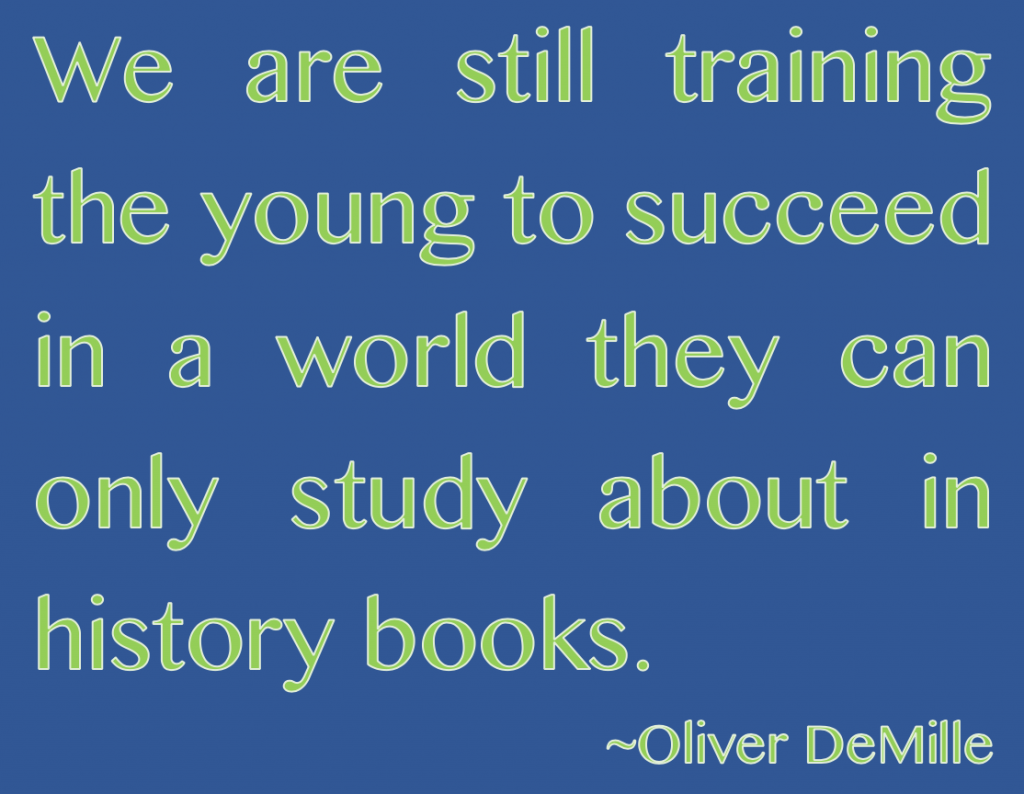 All are outdated now. All fail to prepare our nation’s youth for the actual economy of the 21st century. We are still training the young to succeed in a world they can only study about in history books. Indeed, it is no exaggeration to note that the more time they spend in the modern school system, including the increasingly outdated university campus, the less prepared they’ll likely be to compete effectively in the rough-and-tumble emerging global marketplace with its worldwide competition and demands.
All are outdated now. All fail to prepare our nation’s youth for the actual economy of the 21st century. We are still training the young to succeed in a world they can only study about in history books. Indeed, it is no exaggeration to note that the more time they spend in the modern school system, including the increasingly outdated university campus, the less prepared they’ll likely be to compete effectively in the rough-and-tumble emerging global marketplace with its worldwide competition and demands.
For example, a university degree isn’t what it used to be: The average graduate from the class of 2016 had $37,000 in student debt and couldn’t get a decent job in his or her field—or in any other equivalent field. There are of course exceptions, but the numbers of those leveraging college degrees into effective careers significantly decreases each decade (Note: in North America, Europe, and Latin America, but not in China). In short, today’s young adults are too often receiving a Layer Two education in a world that demands Layer Three knowledge, choices, and skills.
Past, Present, and Future
Few current students are being taught the skills of success that are needed in the new economy. The real economy. Layer Two schools simply do not teach initiative, ingenuity, or innovation. They don’t purposely teach chutzpah, audacity, grit, wise risk-taking, entrepreneurialism, or nerve.
Note that these are precisely the character traits that made America the world’s superpower. And Britain before her, and earlier, Spain and Portugal. These are the very traits that put Egypt at the top, then the Greek city states, and later Rome. These are the characteristics that gave the Gauls, Franks, Anglos and Saxons their edge.
They didn’t have Layer Three maps, to be sure, but they engaged in their era’s “Layer Three” education of the youth, teaching them the skills of resourcefulness, inventiveness, and daring in the face of difficulties. Some of these societies emphasized good purposes (such as life, liberty, and the pursuit of happiness, etc.), while others embraced less noble goals (aristocratic rule of an elite class over the rest of the people, dominance over neighboring nations, a pursuit of wealth through violence, etc.).
But whatever their dreams—good or bad—it was Layer Three skills (initiative, boldness, pluck, enterprise) that lifted every great-power nation in history to the top. As the society that now holds this spot, we (North America, and to a lesser extent Europe) are stunningly lax about teaching these traits. We increasingly downplay them as unimportant and even unattractive. Even “against the rules”. As a result, we have lost our edge. We have largely lost our drive. Too many modern Americans have lost our shared vision and purpose. Unity is a thing of the past.
Indeed, Americans were once unified in the goal to spread freedom, opportunity, and prosperity to the world. Now, the best we seem to be able to muster is a hope to afford college for our kids, and that they’ll get a safe, secure career with good benefits—and as little fuss or struggle as possible. Most colleges themselves seem committed to shielding our young adults from challenges, difficulties, thinking, and any diverse or challenging ideas. This is not the behavior of a nation on the rise. It is the opposite. To paraphrase C.S. Lewis, we are castrating the stallions of the younger generations, then hoping they’ll be fruitful.
But apply Layer Three to the map. Where in the world do we find whole populations burning passionately with drive, initiative, innovation, nerve, entrepreneurial risk-taking, resilience, a hunger to achieve, audacity, ingenuity, resolve, and tenacity? Where do we find the largest concentrations of people who thrive in the face of uncertainty and embrace whatever is hard, and flourish even in an environment of impermanence and difficulty?
When you find a lot of people who have these traits, note where they live. Not in North American or Europe (at least not in large concentrations). In our modern American schooling/career system, for example, our major focus seems to be avoiding uncertainty, impermanence, and difficulty—yet these are the unavoidable realities of the global economy.
Through the Magnifying Glass
Look even closer. Enter this data electronically on a map and you’ll find these traits in China. Indeed, the heartbeat of China is a new “eye of the tiger.” A similar fire burns in India, and a less populated but angrier flame blazes across the Middle East. Layer Three also shows us the rise of such passion in parts of Latin America, Africa, and Russia. These are trigger-points of the decades just ahead.
Where such passion does show up in North America—from California to British Columbia, from Texas to New Hampshire to Newfoundland to Florida, it is usually personal, career-oriented, and commercial. A better job. A marketable education. A promotion.
These hardly match the resolve or intensity of China and its new economic allies across the developing world. They want to lead the world, change the world, and do great things. They want victory, and they see their lives as part of a battle.
In Europe the irony is even more pronounced. The Layer Three map shows numerous pockets of extreme passion in the nations of the E.U.—but zoom in, and you’ll note that most of the people with this kind of fire in the belly are usually recent immigrants from the Southern half of the globe.
The one great exception in North America and Europe is the entrepreneurial class, those who Steve Jobs called the dreamers, the rebels, and the risk-takers. They graduate from college and reject job offers from the Fortune 500 to pursue risky start-ups or launch non-profit charities. Or, increasingly, they skip college altogether, or drop out, and get started on their business or charitable ventures even younger, with an edgier, more idealistic and relevant education.
Their Layer Two parents and grandparents try to talk them out of such endeavors, but these young people have a hunger that typical education and careers won’t fill. They are a Remnant, throwbacks to the earlier Americans who got on the Mayflower, worked and died in Jamestown, went West by horseback or wagon to explore, start, create, and change things. They are the New American Founders, enlightened and ennobled by hindsight of the mistakes of the past, and impassioned by their view of the future – and we desperately need them.
We need a generation of them.
Now.
In the Now
If you are one of their parents or grandparents—worried that your youth are making such choices, decisions that make no sense to you—you can relax. Yes, the kind of risky leadership they are engaging is scary to the older generations who were raised to seek security. But the Third Layer maps clearly show that we no longer live in an era of security.
Even young people who follow the traditional path of college and career suggested by their elders will find that for most people it doesn’t endure in the new economy. We are in an era of tumult, change, and uncertainty—and this is only going to increase for the next few decades.
Those who try to live by Second Layer rules will fall further behind. College degrees won’t bring most of them secure jobs, and seemingly secure careers will suddenly be lost to recessions, new technologies, outsourcing, mergers, regulatory changes, companies sold to foreign investors, and competition, along with a host of other unforeseen realities.
Indeed, those who will do the best in the new economy—whose contributions and livelihoods will end up being the most secure—will be the new entrepreneurial class. The innovators. The roll-with-the-punches change agents. Those who can think, lead, initiate, and wisely assess risk. We are indeed entering the Age of Risk, and this massive shift in the world economy is here to stay. Business has already caught on and is changing things to meet the new reality. But education is still in denial, along with most in government.
Sadly for those who allow themselves to be swayed by the current denial of many in the educational sector and Washington, people caught in Second Layer thinking will be the losers of the next thirty years. The winners will be Third Layer risk takers who tenaciously create ways to succeed in the new environment. Who make a way.
Many of them are already looking at the world through the lenses of Third Layer maps and mindsets, and they understand something very real: The future is theirs. Moreover, our future is in their hands.
The more we can do to help and support them, the better things will turn out for all of us. The successes and failures of our entrepreneurs will determine the future. Just as it has determined the past.
Fall or Rise
This reality causes serious concerns. Anyone who takes a good look at the current university campus model of learning finds a number of problems. Not the kind of challenges that demand reform, mind you, but rather a systemic, structural network of problems that will require a true educational revolution. The need for change is, to put it lightly, drastic.
Just consider the following commentaries by some of today’s top thinkers on the topic of the emerging economy and its ties to the type of education we now need. For example, MIT’s Eric Brynjolfsson and Andrew McAffee wrote, in a section of their book labeled “Failing College”:
“Richard Arum and Josipa Roska…and their colleagues tracked more than 2,300 students enrolled full-time in four-year degree programs at a range of American colleges and universities. Their findings are alarming: 45 percent of students demonstrate no significant improvement on the CLA [Collegiate Learning Assessment, which tests ‘critical thinking, written communication, problem solving, and analytic reasoning’] after two years of college, and 36 percent did not improve at all even after four years.
“The average improvement on the test after four years was quite small…. What accounts for these disappointing results? Arum, Roska, and their colleagues document that college students today spend only 9 percent of their time studying (compared to 51 percent on ‘socializing, recreating, and other’), much less than in previous decades, and that only 42 percent reported having taken a class the previous semester that required them to read at least forty pages a week and write at least twenty pages total.
“They write that, ‘The portrayal of higher education emerging from [this research] is one of an institution focused more on social than academic experiences. Students spend very little time studying, and professors rarely demand much from them in terms of reading and writing.’
“They also find, however, that at every college studied some students show great improvement on the CLA. In general, these are students who spent more time studying (especially studying alone)…”[v]
The authors also wrote: “The good news, though, is that technology is now providing more…opportunities than ever before. Motivated students and modern technology are a formidable combination. The best educational resources online allow users to create self-organized and self-paced learning environments—ones that allow them to spend as much time as they need with the material, and also to take tests that tell them if they mastered it.”[vi]
Futures Past
The quality of learning in such online venues is very often extremely high. For example, when a graduate level AI course at Stanford was opened to participants on the Internet for free, over “160,000 students singed up for the course. Tens of thousands of them completed all exercises, exams, and other requirements, and some of them did quite well. The top performer in the course at Stanford, in fact, was only 411th best among all the online students. As Thrun [the instructor] put it, ‘We just found over 400 people in the world who outperformed the top Stanford student.’”[vii]
Likewise, “…Laszlo Bock, Google’s senior vice president of people operations, notes that college degrees aren’t as important as they once were. Bock states that ‘When you look at people that didn’t go to school and make their way in the world, those are exceptional human beings. And we should do everything we can to find those people.’ He noted in a 2013 New York Times article that the ‘proportion of people without any college education at Google has increased over time’—on certain teams comprising as much as 14 percent.”[viii]
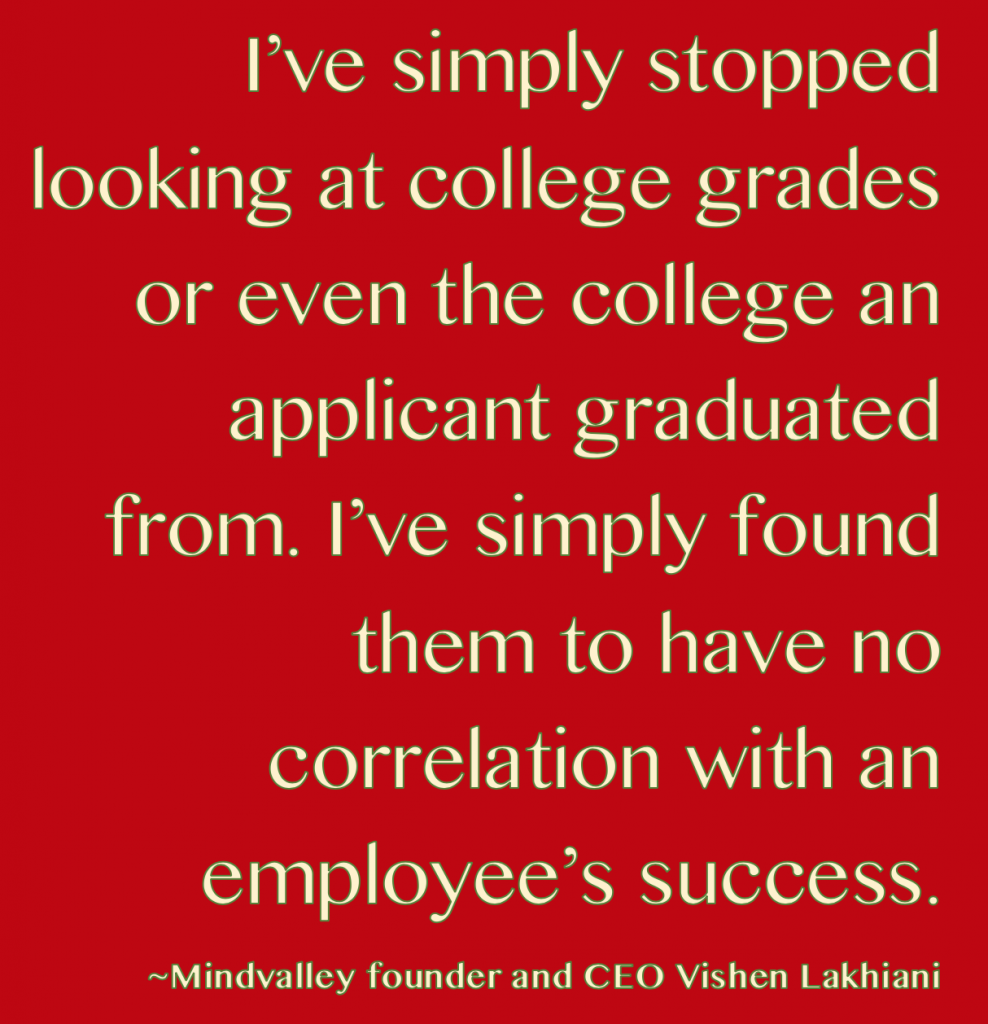 Mindvalley founder and CEO Vishen Lakhiani wrote: “I’ve personally interviewed and hired more than 1,000 people for my companies over the years, and I’ve simply stopped looking at college grades or even the college an applicant graduated from. I’ve simply found them to have no correlation with an employee’s success.”[ix] Sadly, too many people still hold on to old educational models that no longer deliver what they once did, or what they now promise.
Mindvalley founder and CEO Vishen Lakhiani wrote: “I’ve personally interviewed and hired more than 1,000 people for my companies over the years, and I’ve simply stopped looking at college grades or even the college an applicant graduated from. I’ve simply found them to have no correlation with an employee’s success.”[ix] Sadly, too many people still hold on to old educational models that no longer deliver what they once did, or what they now promise.
Lakhiani put it this way: “But here’s the problem. Most of us are using systems that have long [since] become obsolete. As Bill Jensen said in his book Future Strong: ‘Even as we enter one of the most disruptive eras in human history, one of the biggest challenges we face is that today’s systems and structures still live on, past their expiration dates. We are locked into twentieth-century approaches that are holding back the next big fundamental shifts in human capacity.’”[x]
Bestselling author Neil Pasricha told the following story: “A senior partner at a prestigious global consulting firm once said to me after a boozy dinner: ‘We find Type A superachievers from Ivy League schools who need lots of reward and praise…and then dangle carrots just over the next deadline, project, and promotion, so they keep pushing themselves. Over every hill is an even bigger reward…and an even bigger hill.’”[xi] This is enlightening. It’s not the actual education the big corporations are looking for as much as a sense of over-achievement and needing lots of rewards and praise.
Look at this same scenario from the student’s viewpoint. Is this really the career environment we want our young people to pursue? Is this the life we want for them, or the use of their talents that will best benefit the world—or bring them the most fulfillment and happiness? Sometimes, the answer may be yes. But very often, it isn’t.
Billionaire Paypal co-founder and educational innovator Peter Thiel said it even more bluntly: “Higher education is the place where people who had big plans in high school get stuck in fierce rivalries with equally smart peers over conventional careers like management consulting and investment banking. For the privilege of being turned into conformists, students (or their families) pay hundreds of thousands of dollars in skyrocketing tuition that continues to outpace inflation. Why are we doing this to ourselves?”[xii] After happily reminiscing that he eventually took the entrepreneurial path of founding tech companies instead of following his major in graduate school, Thiel said[xiii],
“All Rhodes Scholars had a great future in their past.”
The Next Normal
The modern college/career system, which is increasingly Level Two education in the new economy, is more and more outdated. In the book Platform Revolution, technology experts Geoffrey G. Parker, Marshall W. Van Alstyne, and Sangeet Paul Choudary argue that the old-style university model is surviving largely because government regulations keep true innovators from competing on anything close to a level playing field.[xiv] If this were to change, no doubt online educational platforms would do for education what Amazon has done for bookstores (and other retailers), Uber has done for taxi services, Wikipedia has done to the encyclopedia publishing industry, and online news sources have done to many newspapers.[xv] Again, over 400 online students tested better than the top Stanford student in the exact same class.
Parker, Alstyne, and Choudary wrote: “The long-term implications of the coming explosion in educational experimentation are difficult to predict with certainty. But it wouldn’t be surprising if many of the 3,000 colleges and universities that currently dominate the U.S. higher education market were to fail, their economic rationale fatally undercut by the vastly better economics of platforms.”[xvi]
Just imagine much cheaper and higher quality higher educational offerings for all. Consider the work by Khan Academy,[xvii] Minerva,[xviii] Peter Thiel, and other educational innovators. If the government ever ends the current educational monopoly supporting the old-style conveyor-belt approach to higher education, the results will likely dwarf the kind of change we witnessed with the advent of cable television programs, or when Ma Bell was deregulated and replaced by an entirely different kind of telecommunications.
Parker and his colleagues also noted:
“In the years to come, the spread and increasing popularity of teaching and learning ecosystems will have an enormous impact on public school systems, private schools, and traditional universities. Barriers to entry that have long made a first-class education an exclusive, expensive and highly prestigious luxury good are already beginning to fall.
“Platform technologies are making it possible for hundreds of thousands of students to simultaneously attend lectures by the world’s most skilled instructors, at minimal cost, and available anywhere in the world that the Internet is accessible. It seems to be only a matter of time before the equivalent of a degree from MIT in chemical engineering will be available at minimal cost in a village in sub-Saharan Africa.
“The migration of teaching to the world of platforms is likely to change education in ways that go beyond expanded access—important and powerful as that is. One change that is already beginning to happen is the separation of various goods and services formerly sold as a unit by colleges and universities. Millions of potential students have no interest in or need for the traditional college campus complete with an impressive library, a gleaming science lab, raucous fraternity houses, and a football stadium.”[xix]
They’d rather pay a lot less and get a better learning experience.
Focusing In
“Education platforms are also beginning to unbundle the process of learning from the paper credentials traditionally associated with it.”[xx] The authors note that many students now “…appear to be more interested in the real-world abilities they are honing than in such traditional symbols of achievement as class transcripts or a diploma.”[xxi] They want to learn knowledge and skills that help them achieve their life and financial goals, not traditional symbols that no longer really work in the 21st century economy.[xxii] Results-Based Learning is increasingly in demand.
For example, “A high ranking on TopCoder, a platform that hosts programming contests, will earn a developer a job at Facebook or Google just as fast as a computer science degree from Carnegie Mellon, Caltech, or MIT. Platform-based students for whom a traditional credential is important can often make special arrangements to receive one—for example, at Coursera, college credit is a ‘premium service’ you pay extra for.”[xxiii] Another example is Duolingo, a crowdsourcing foreign language platform that is teaching more people a foreign language than all the students studying foreign language “in high school in the U.S. combined.”[xxiv]
“Once there is an alternative certification [to college degrees] that employers are willing to accept,” Parker and his colleagues affirm, “universities will find it increasingly difficult…. Unsurprisingly, developing such an alternative certification is among the primary goals of platform education firms such as Coursera.”[xxv] Other organizations are trying to build such educational platforms as well, including Udacity, Skillshare, edX, and others.[xxvi] Even top specialty schools, like MIT and Julliard, are offering open enrollment online courses. (Their selling point is often focused on “Learn from the MIT faculty,” or “Learn from the Julliard faculty,” a nod to the new reality that mentoring is becoming even more important than institutionalism.)
No doubt more innovative higher educational options will thrive (and at the high school level as well), until some of them restructure modern education like eBay, Amazon, Facebook, Uber, the Internet, or Google have done for other fields. As far as student learning is concerned, numerous self-produced online tutorials, on platforms like YouTube and others, provide excellent educational opportunities—both to learn and teach.
All of these developments and trends are part of Third Layer education, and they are almost universally moving away from outdated traditions, methods, and beliefs of conveyor-belt-style education and schools. A new economic era is already here, and for those who know what to look for, new educational models are rising to support what is now needed. Third Layer, Results-Based learning is the future of effective education. The focus is on individualized learning, thinking, and applying rather than conveyor-belt schooling.
The new maps are here, if we’re willing to look.
(This topic is addressed in more detail in Hero Education by Oliver DeMille, available here>>)
[i] Parag Khanna, 2016, Connectography, xvii.
[ii] Harper’s Index, Harper’s Magazine, September 2015.
[iii] The Brexit and election of Donald Trump didn’t seem to make much difference in this trend. See, for example, Geoffrey Smith, “The Brexit Crisis That Wasn’t,” Fortune, October 1, 2016; See also, Jeff Immelt, “After Brexit, Global is Local,” Fortune, August 1, 2016, 71-72.
[iv] Joshua Cooper Ramo, 2016, The Seventh Sense, 122.
[v] Erik Brynjolfsson and Andrew McAfee, 2014, The Second Machine Age, 197-198.
[viii] Cited in Vishen Lakhiani, 2016, The Code of the Extraordinary Mind, 24.
[xi] Neil Pasricha, 2016, The Happiness Equation, 150.
[xii] Peter Thiel, 2014, Zero to One, 36.
[xiv] See Geoffrey G. Parker, Marshall W. Van Alstyne, Sangeet Paul Choudary, 2016, Platform Revolution, 263-268.
[xvii] For example, see commentary in Brynjolfsson, 199.
[xviii] For example, see commentary in Parker, 268.
[xxvi] See, for example, ibid., 265.
Category : Blog &Business &Citizenship &Community &Culture &Current Events &Economics &Education &Entrepreneurship &Generations &Government &History &Independents &Information Age &Leadership &Liberty &Mini-Factories &Mission &Politics &Producers &Prosperity
Jefferson Madison Debates: John Adams on How to Fix Washington D.C. in 1791 and 2018
June 28th, 2018 // 7:26 pm @ Oliver DeMille
“Odd, that so many should favor frames that seemed to be trying to outdo the art they held.”
~Brandon Sanderson, The Alloy of Law
What You Think You See
 In the old American West, a façade town featured two- and sometimes three-story buildings lining Main Street, so visitors to the town would be impressed with how up-and-coming the community must be.
In the old American West, a façade town featured two- and sometimes three-story buildings lining Main Street, so visitors to the town would be impressed with how up-and-coming the community must be.
But when a person walked around to the side and back of the buildings, it turns out they’d find mostly one-story structures—sometimes little better than shacks or huts.
A few were even a façade built on the front of a rickety lean-to.
Some were respectable buildings, but they were usually made of adobe or pine rather than the fine hardwood edifices promised by their Main Street facades.
And, as I mentioned, they were only one story tall despite their appearance from the front.
Indeed, the only purpose of the two- or three-story façade was to impress.
In modern times, the idea that perception is reality has reached the level of myth.
To Conform or Not To Conform
It is taught in various circles as unquestioned truth, parroted in movies and television programs as a lasting principle, and often used to scold would-be individualists into working harder to conform and fit in.
“We must impress others to get ahead in the world,” the common wisdom seems to assure us.
C.S. Lewis lambasted this view in his classic, “The Inner Ring.”
If you spend your life trying to impress and fit in, as almost everyone does, he warned, you’ll waste a lot of time and energy and miss many of the important things that really matter in life.
Moreover, he predicted, you’ll fail to appeal to the only real society of substance, the other people who ignore trying to impress and fit in and instead set about doing good things in the world without worrying what others think.
He called this group the true inner ring, whose motto was something along the lines of “perception is merely perception—truth, reality, integrity and quality are what matter.”
John Adams wrote about this topic in his little-known and seldom-read classic, Discourses on Davila, which may be his best book next to Defence of the Constitutions of the United States (in fact, he referred to Davila as the fourth volume of Defence).
He said that nearly every person is plagued by a debilitating desire to be esteemed by others, to impress and fit in, to be admired, and that this is the basis of many human flaws including jealousy, envy, ambition, vanity, hatred, revenge, pride, and most human pain.
These are Adams’ specific words.
Adams said this desire for admiration is as real as hunger, and the cause of more suffering, anxiety, stress and disappointment than famine.
In contrast, the really good things in life, including virtue, nobility, honor, loyalty, wisdom, service, strength and so on, may or may not increase the admiration of others, but are often valued only to the extent that they do.
Competing for Mediocrity
Sadly, many people seek these things only if, and to the degree that, they increase admiration from others.
Far too many things are sought by mankind only because they attract “attention, consideration, and congratulations…” Adams said.
Likewise, too many good and important things are not pursued by many people because they do nothing to boost one’s status or station.
By the way, the point of Adams’ book on Davila is to show that because of basic human nature—built on this inner drive of nearly all men and women to rise in station, and not just to rise, but to rise above other people—there will always be conflicts in human societies and institutions.
His solution was to create separate branches of power, and to set up the government so these branches could check and balance each other in a way that no one government entity could become too powerful.
The result, he said, would be that the people in the nation would be able to live free of overreaching government.
In the process of making this argument he spends a great deal of time showing that this drive to fit in, impress, and in fact outdo other people (by being more impressive and fitting in better than them), was a serious obstacle to human happiness in families, schools, business and all facets of society.
When people become more knowledgeable and learned, for example, they tend to engage in more, not less, conflict with other learned persons.
He was not talking of debate, but of serious conflict.
Thus our schools and great universities, which could be the salvation of society in many ways, are distracted from their potential because their leading inhabitants are constantly striving for Reputation, Notoriety, and Celebration.
These three words are those used by Adams, which he capitalized for emphasis in his book.
Likewise, Adams laments, our branches of government are unable to truly lead because those who should be our best hope for great progress immediately, upon being elected or appointed to office, set out to compete with all other officials for more Fame, Glory, Reputation and Credit.
Again, these are Adams’ words.
Growing or Shrinking
Voters send representatives, presidents and others to do their will, to improve things, but the real work of most men and women lifted to leadership is to win this contest with each other.
“Improve the Nation, or Impress the Nation. That is the question.”
And the drive to impress nearly always wins the day.
Adams wrote of humanity’s so-called honors in withering terms:
“What is it that bewitches mankind to marks and signs? A ribbon? a garter? a star? a golden key? a marshall’s staff? or a white hickory stick?”
He is mocking us now.
“Though there is in such frivolities as these neither profit nor pleasure, nor anything amiable, estimable, or respectable, yet experience teaches us, in every country of the world, they attract the attention of mankind more than…learning, virtue, or religion.”
Furthermore, Adams continues, they are sought by the poor, who believe such honors will lift them to equal status with the rich, and they are sought by the rich, who believe that without these symbols they will be lowered to the status of the poor.
This is the great challenge of human progress—we ignore our great potential to focus on silly attempts to impress.
We do it as children, as youth, as adults, and in old age.
The solution, in the case of academia, is to closely avoid putting scholars or administrators in charge of education, but leave oversight to the parents.
For government, the fix is to allow the people to frequently replace their officials at the election booth—to remove them as soon as they forget to do what the people sent them for.
Symbol Above Currency
Adams points out that ribbons, medals, titles, and other symbols of man’s honor, including the white hickory sticks of certain secret societies, aren’t of much use in real life.
Though, if you are freezing, the hickory stick can at least be ignited and bring some warmth.
But these ornaments are nevertheless widely sought because they are symbols of acceptance, fitting in, and impressing others.
Such symbols show that, in fact, the Status Motive is even stronger in humanity than the Profit Motive.
Indeed, giving war heroes and others who accomplish great acts of heroism large sums of money, cars, vacations or estates would be seen as crass by most modern eyes.
Yet these are exactly what many of the ancients gave their champions and heroes, though chariots and carriages were more in vogue than cars.
We give symbols for the highest achievements, precisely because their lack of monetary value communicates just how highly we esteem them—far above money.
For Adams, the honors and symbols are frivolities only because we seek the honors and symbols rather than the actions for which they are awarded.
This is deep insight into human nature, because for true heroes the ribbons and medals mean much less than simply knowing what they did.
Flattery and Failure
It is wonderful to honor heroic acts that truly merit our admiration and thanks, but too often, as Adams puts it, the “great majority trouble themselves little about merit, but apply themselves to seek for honor…”
This is a serious indictment.
He further says that most people try to gain such honors not by going out and serving in ways that merit them.
Such service would be too difficult, or dangerous, or risky.
Besides, just meriting great honors doesn’t ensure that one will receive them.
After all, we are assured, “perception is reality”.
So many people decide that a much better course is to ensure the world’s admiration the old-fashioned way, by directly seeking prestige and hiring publicists, PR firms, and commissioning scholarly studies and the support of experts.
Adams says it this way:
“…by displaying their taste and address, their wealth and magnificence, their ancient parchments, pictures, and statues, and the virtues of their ancestors; and if these fail, as they seldom have done, they have recourse to artifice, dissimulation, hypocrisy, flattery, empiricism…”
But this is more than an interesting philosophical discussion about human nature.
It actually cuts to the very heart of reality.
Because of our thirst for honors, and because façade honors are easier to obtain, all our manmade institutions eventually fail.
Adams mourns that government cannot solve the problems of humanity, nor will institutions of commerce and business.
Plague of Power
Families and churches come the closest, but even here we spend the generations warring about whether husband or wife should be the head, how long fathers should maintain dominance over their sons, and whether newly married couples now report to paternal or maternal grandfathers.
Likewise, too many churches in history took up arms against unbelievers, and various religions and secular groups resort to violence when they fail to convince in other ways.
Indeed, as soon as men create institutions of any kind, they usually begin to war—within the institution and/or with other institutions.
The solutions, the real fixes to our challenges, Adams teaches, will not come from manmade institutions.
We should set up the best institutions possible, but we can’t rely on them for everything because man’s hunger for approval and applause is always at work undermining progress.
Adams quotes the English poets to make his point:
“The love of praise, howe’er conceal’d by art,
Reigns, more or less, and glows, in every human heart;”
—Edward Young
“All our power is sick.”
—William Shakespeare
If “All our power is sick”, indeed. If so, how can mankind progress?
It turns out there is a solution, and Adams is excited to share it.
Building Greatness
In the cases of family, church, relationships and business, one should simply dedicate one’s life and efforts to truly serving in genuine, if challenging, ways that really make a positive difference.
This was also recommended by C.S. Lewis, who said to ignore trying to impress and instead set out to genuinely serve.
Both Adams and Lewis note that such service is only authentic when we give up concern about getting the credit.
But Adams wants our political leaders to do the same.
He sees real government leadership as deep, committed service, devoid of seeking credit or reward.
He doubts that many will truly forget their drive to impress and seek only to frankly serve, but he holds out hope that a few will rise to such heights of true leadership.
The best honors for such exceptionally great leaders aren’t the praise or baubles of men but the highest of all tributes—emulation.
And in this Adams gives us mankind’s solution to its biggest challenges.
Specifically, while mankind limits itself from great achievements to fight the petty battles of impressing others, becoming more impressive than others, fitting in, and fitting in better than others, the solution is to emulate those who do it better.
What Leadership Is
Parents who emulate great parents are the hope of the world, as are great teachers, inventors, artists, statesmen, leaders, entrepreneurs and others who emulate the greats.
Emulation includes improving upon the best of the past, and as generations of parents and other leaders emulate the best and improve upon it, the world drastically improves.
This, as Adams puts it, is a desire not to impress and fit in, “but to excel,” and “it is so natural a movement of the human heart that, wherever men are to be found … we see its effects.”
Moreover, Adams assures us, it blesses communities and society as much as it helps individuals succeed.
For those who are religious, nothing is more effective than trying to emulate the Son of God, the great prophets, Buddha, and other examples of charity, service and wisdom.
We fall short in many ways, but in trying to answer the question, “What Would Jesus Do?,” as the modern saying goes, we reach for our very best.
Our greatest heroes, regardless of our views on religion, should be the great men and women of history whose sacrifice and greatness makes them most worthy of emulation.
Emulation is as strong an emotion as seeking admiration, and in fact most children learn emulation first.
Which brings us to the topic of this article—How to fix Washington and put America back on track as a standard for freedom, opportunity and goodness in the world.
According to John Adams (and C.S. Lewis, Alexander Solzhenitsyn, and many others), the answer is not to turn to leadership from our big institutions, even if they have as much power as the White House, Congress, Wall Street, Hollywood, Silicon Valley, the Justice Department, the Federal Reserve or even the Supreme Court and Madison Avenue.
The solution lies in leadership, but not from the top down.
We will not get back on track as a society until we lead from below, until we become a society of leaders, and the right kind of emulation is our most powerful means of lasting influence and change.
Who you and I choose to emulate—really, truly, deeply, fully—will determine the future.
Becoming Our Future
It is the most powerful symbol, because who we want to be like on the greatest days of our lives will color the rest of our time on earth.
But it is much more than a symbol.
Too much of modern life is merely a façade.
Too many of our institutions are hollow shells of what we need them to be—and of what they claim to be.
Too often we choose the path of prestige over the path of quality.
Too frequently we listen to the credible rather than the wise.
Too many of our hours and days are spent on the things that are least important.
It was Nietzsche, I think, who said that modernism began when we started substituting the morning paper for our morning prayers.
Allan Bloom called this the closing of the American mind.
Adams told us that such things are hollow, but in the Information Age the voice of understanding is too frequently drowned out by the roar of the crowd.
In all this, however, there is an anchor.
Who we decide to emulate, and how faithfully we do so, will make the future.
And that goes for Washington as well.
Category : Blog &Citizenship &Community &Constitution &Culture &Current Events &Economics &Education &Generations &Government &History &Independents &Information Age &Leadership &Liberty &Mission &Politics &Service &Statesmanship











